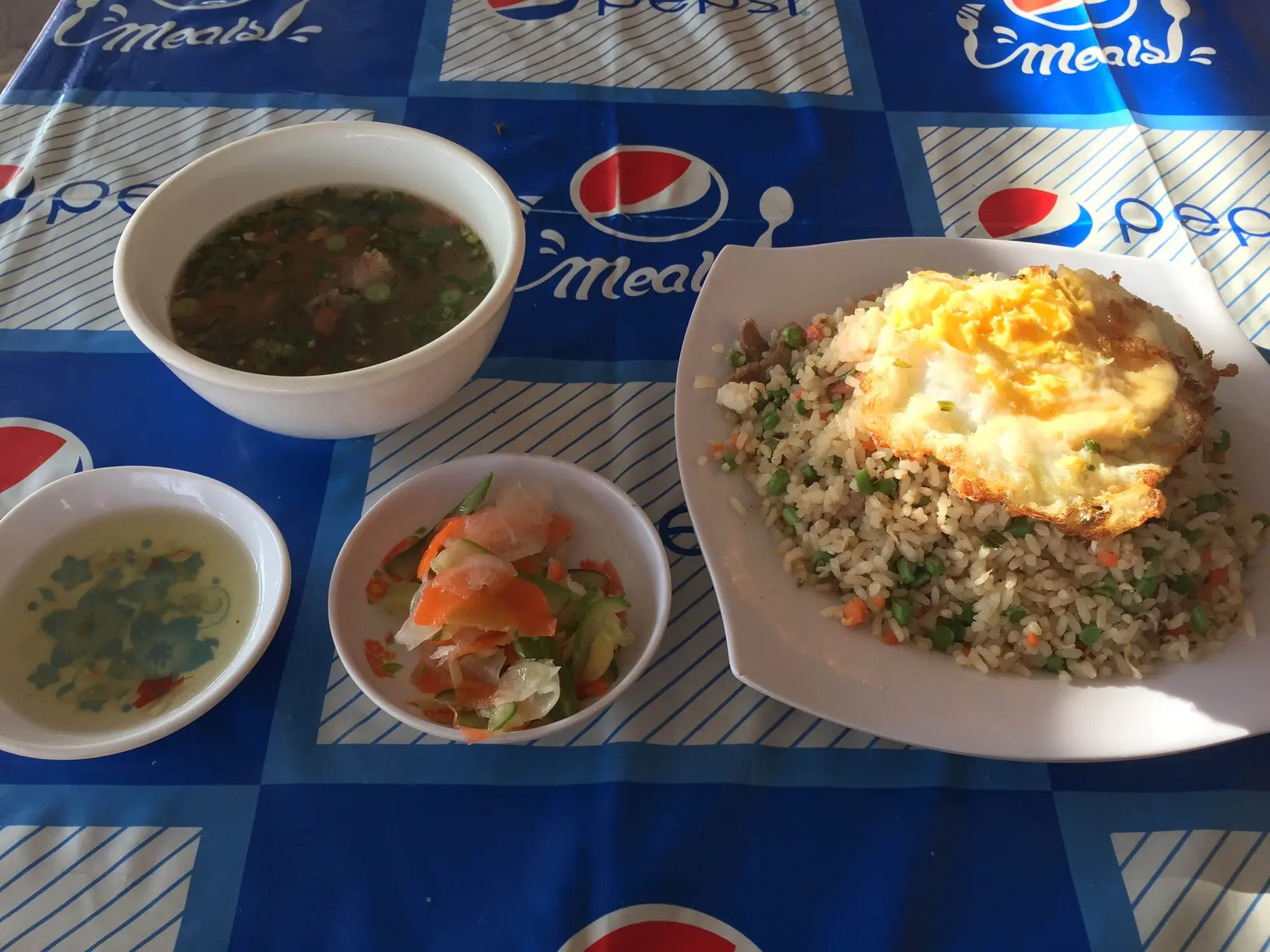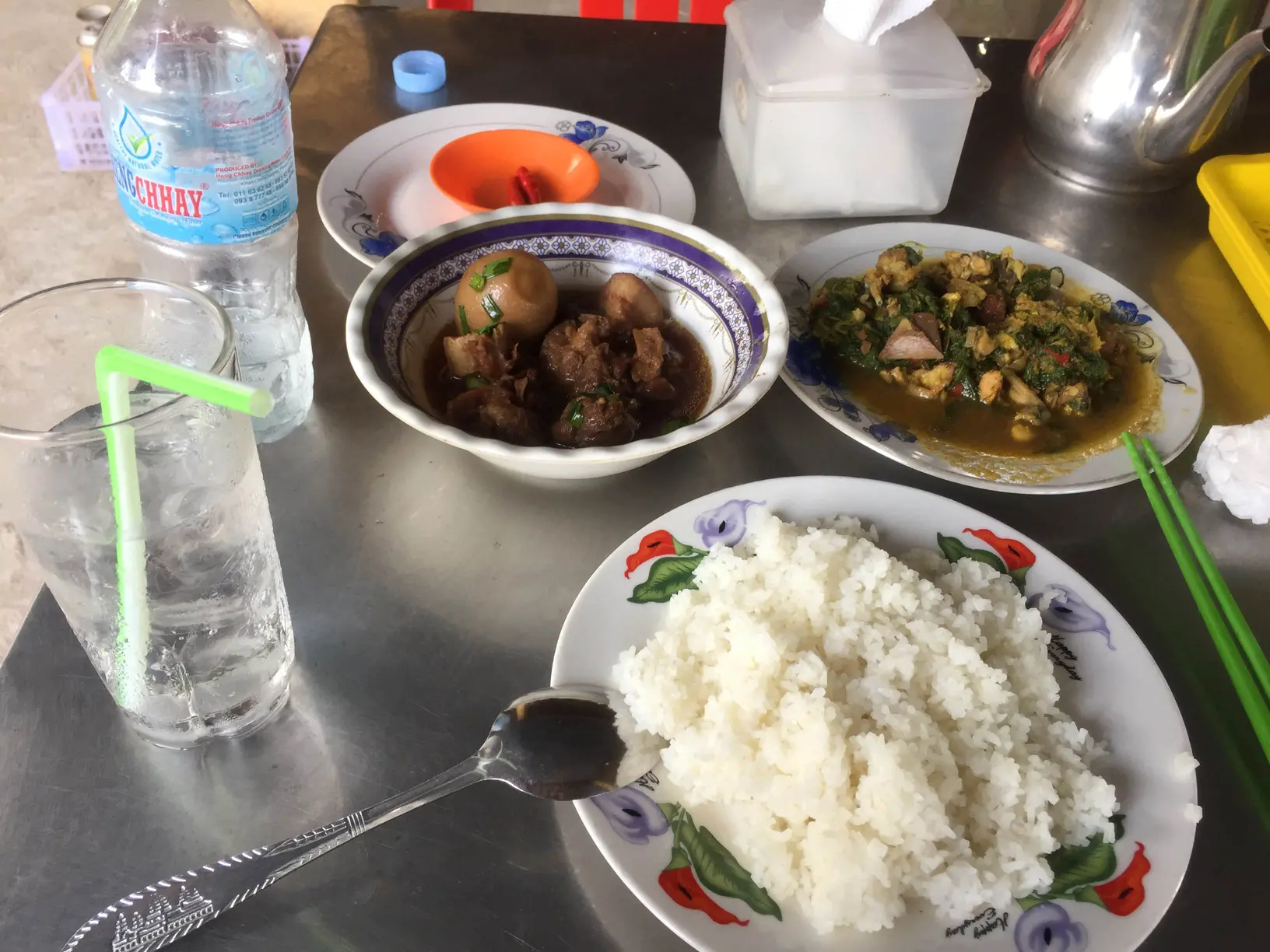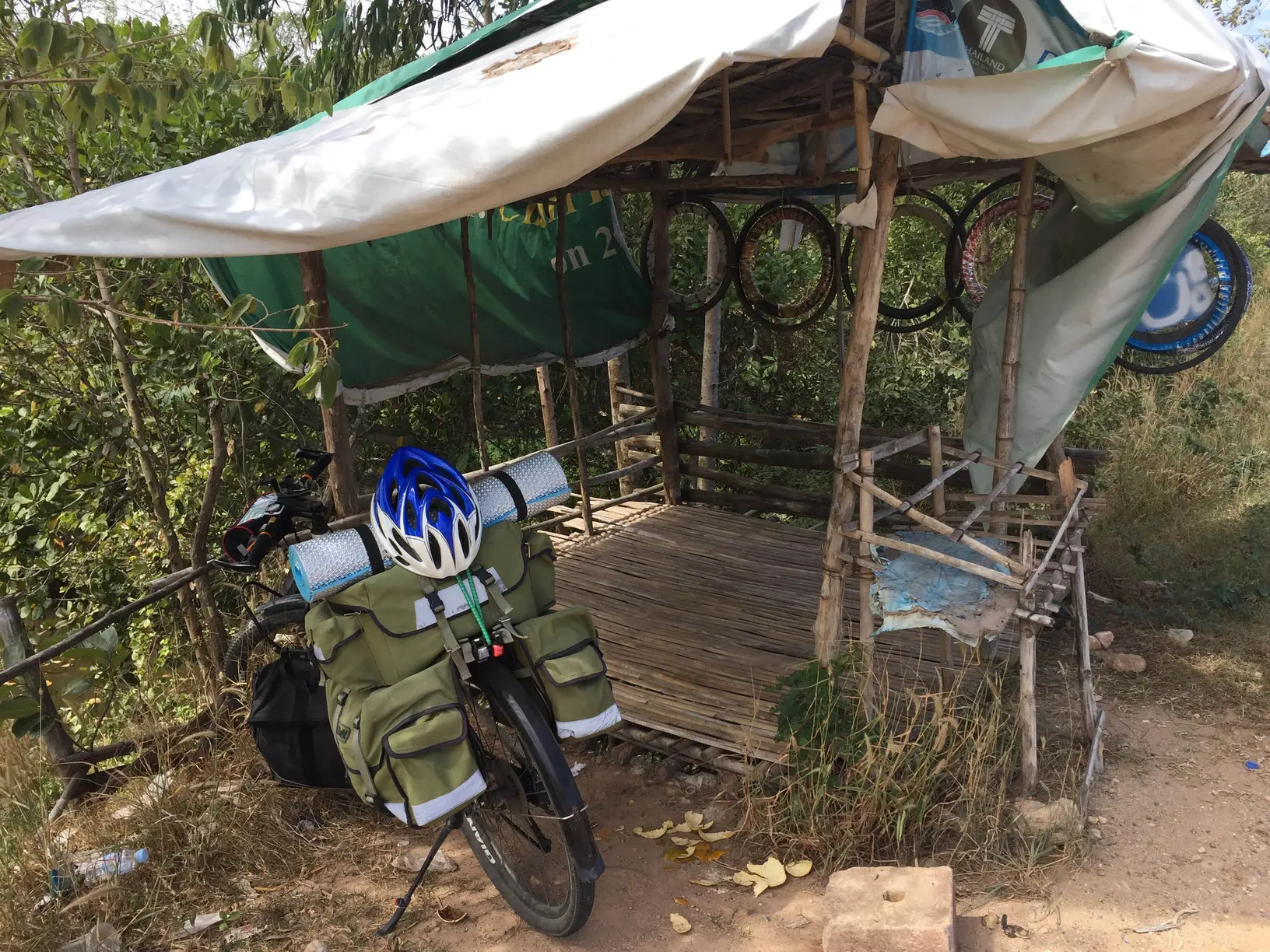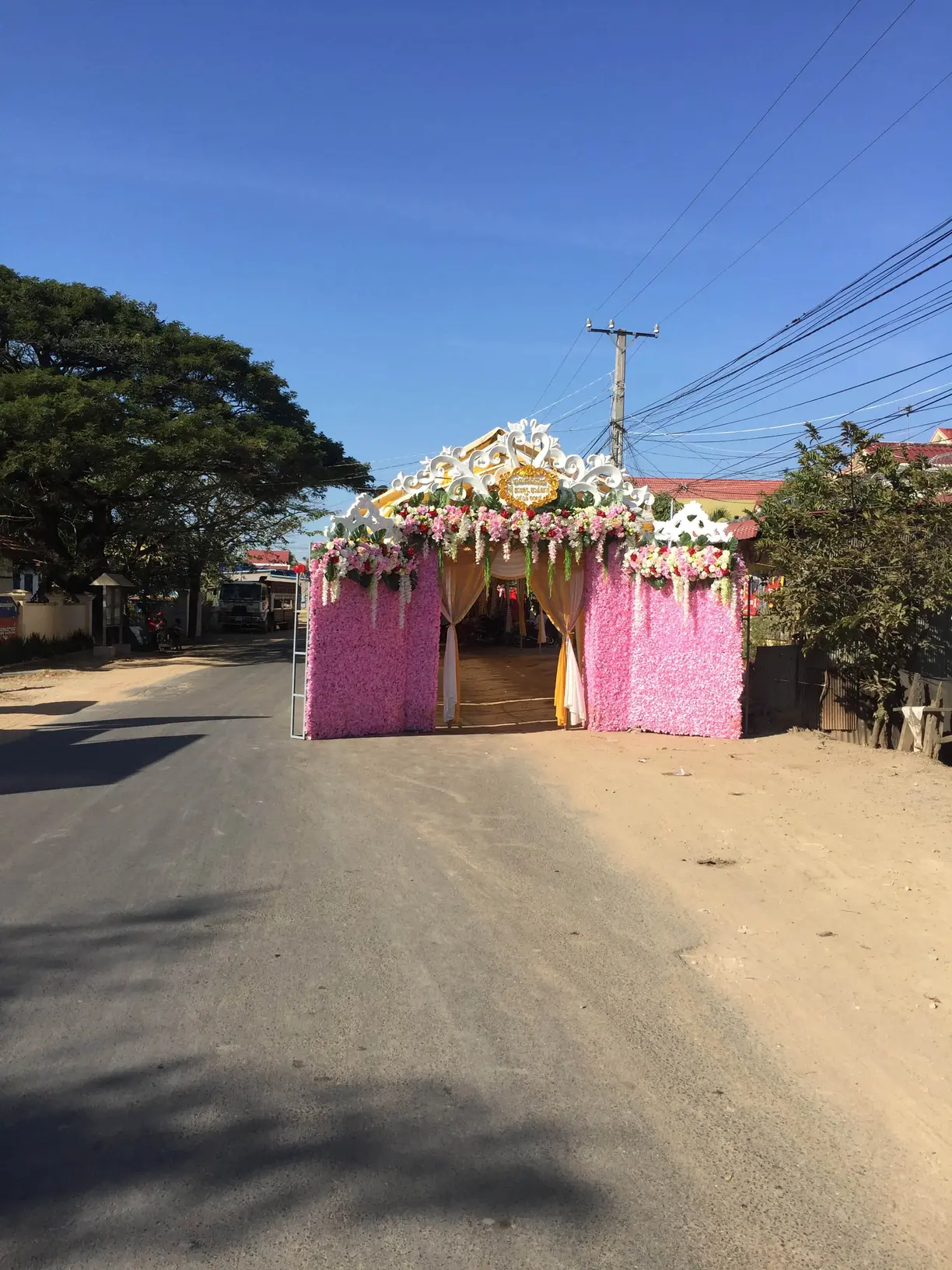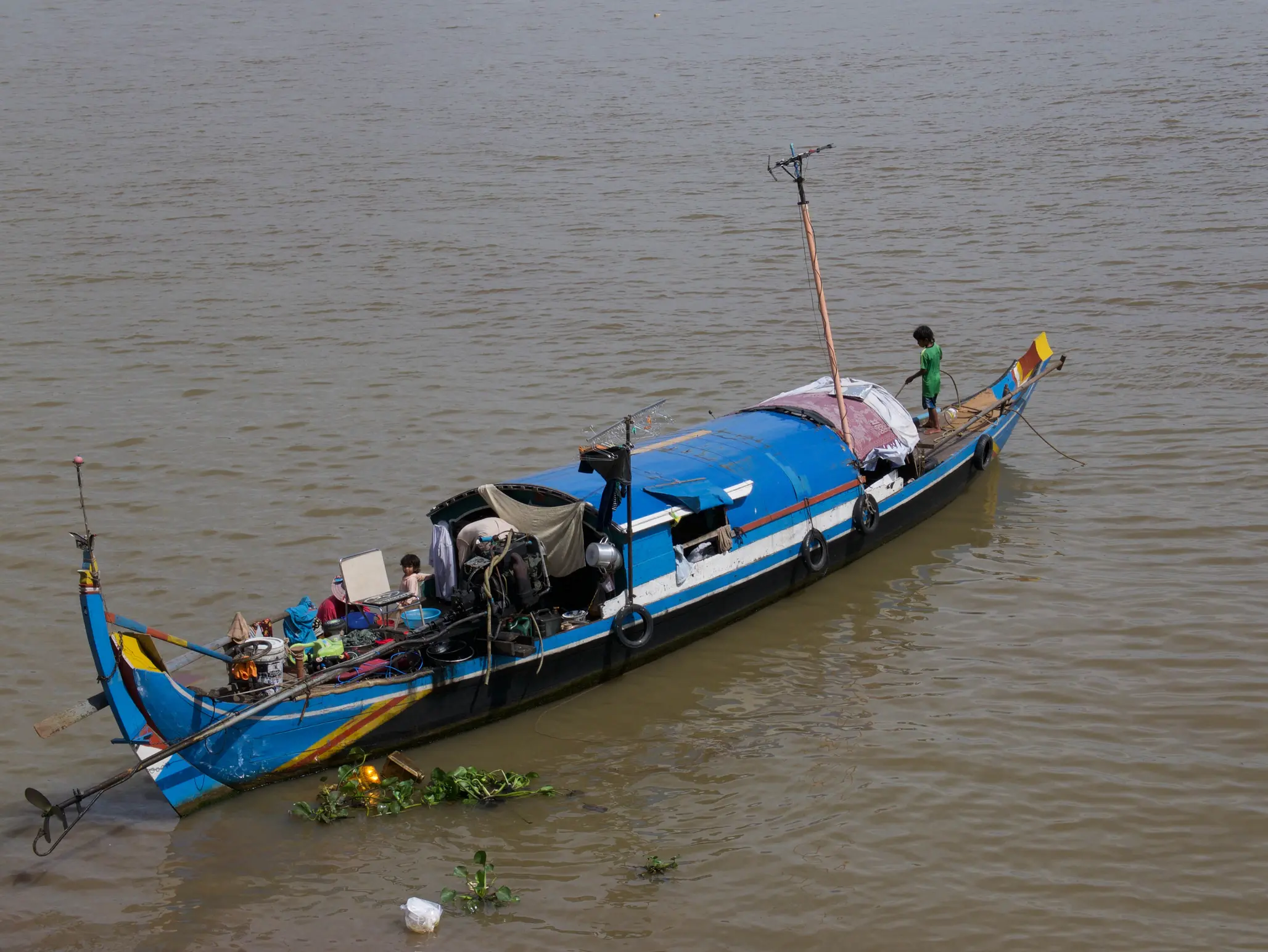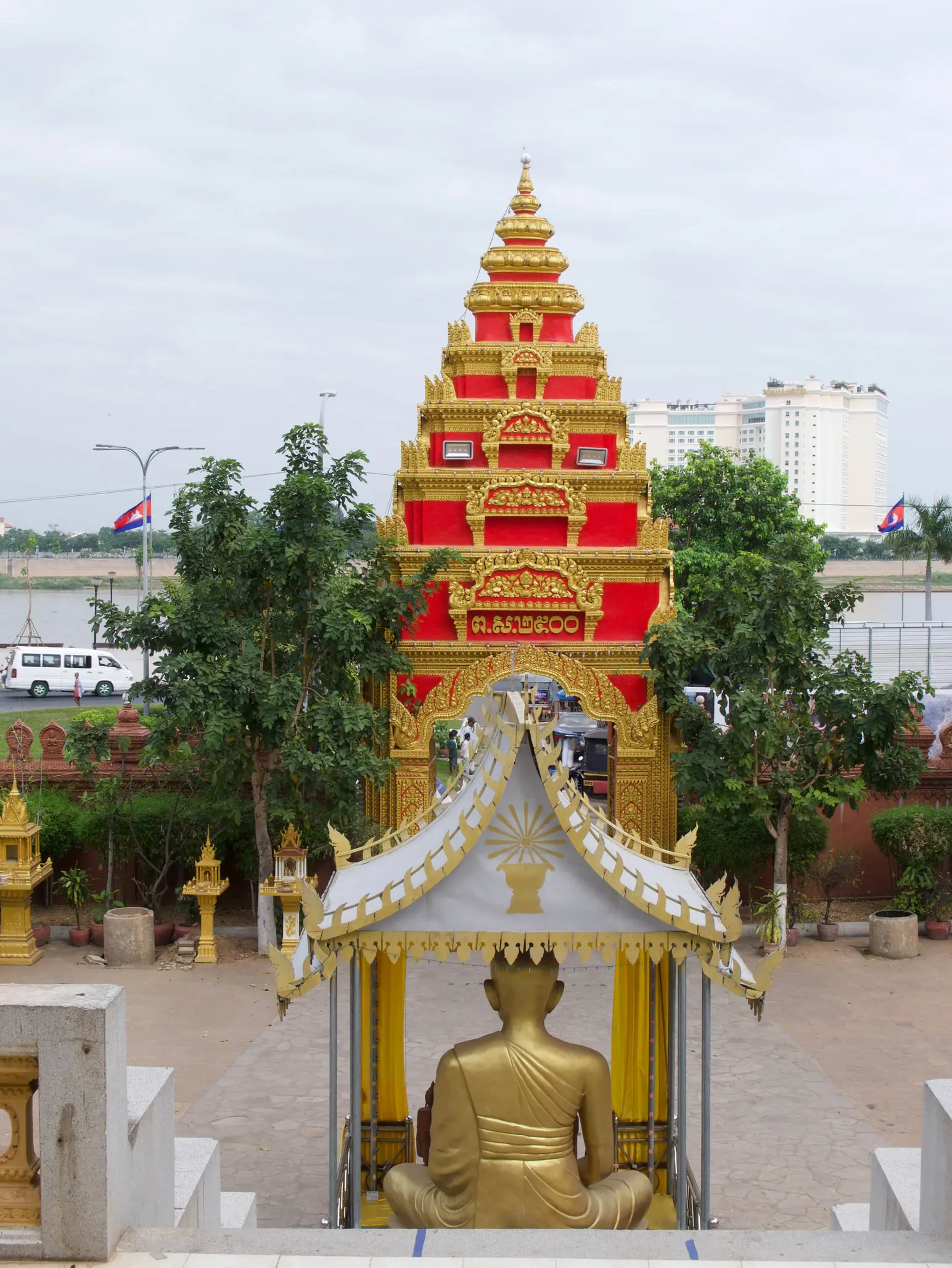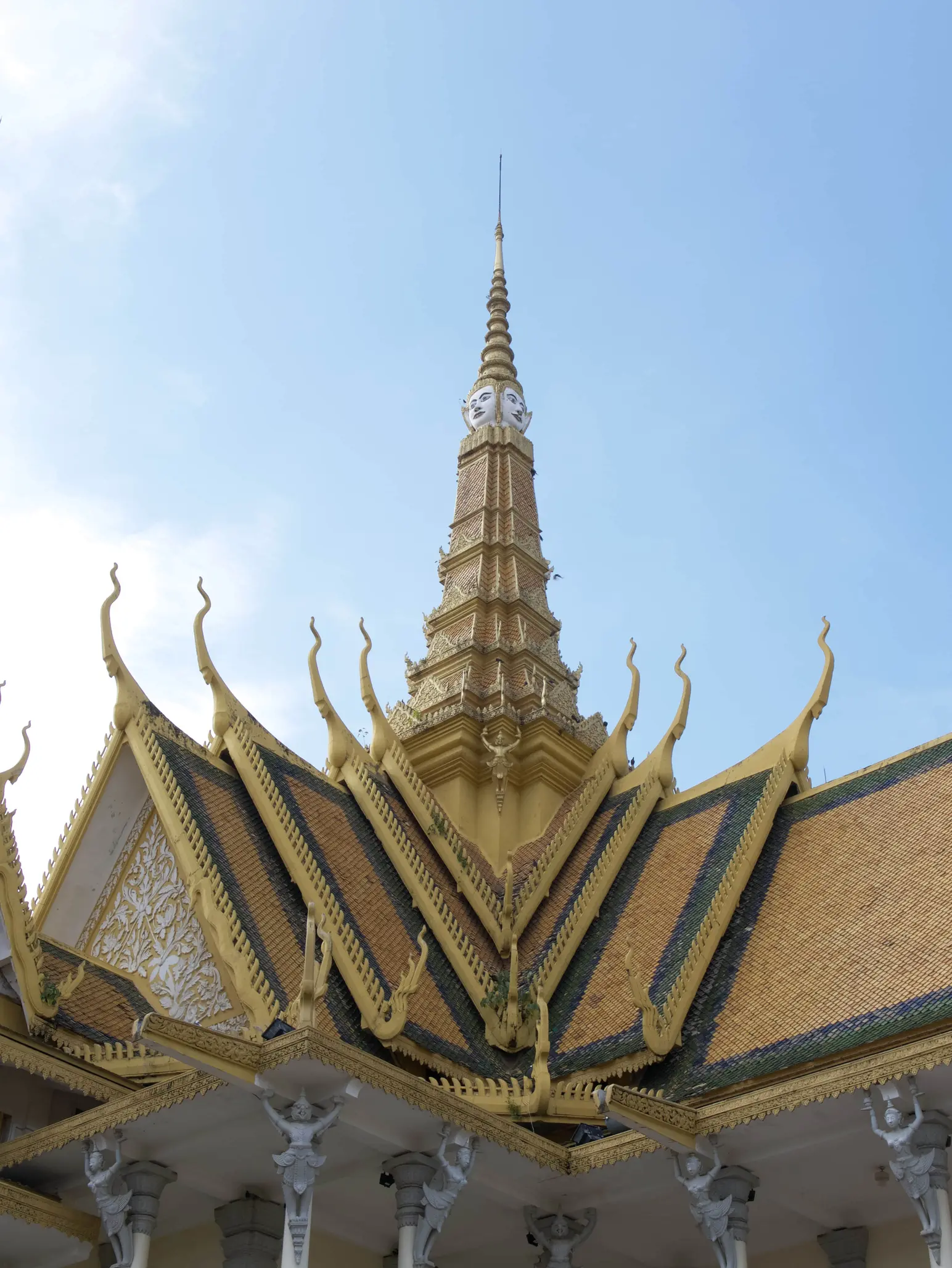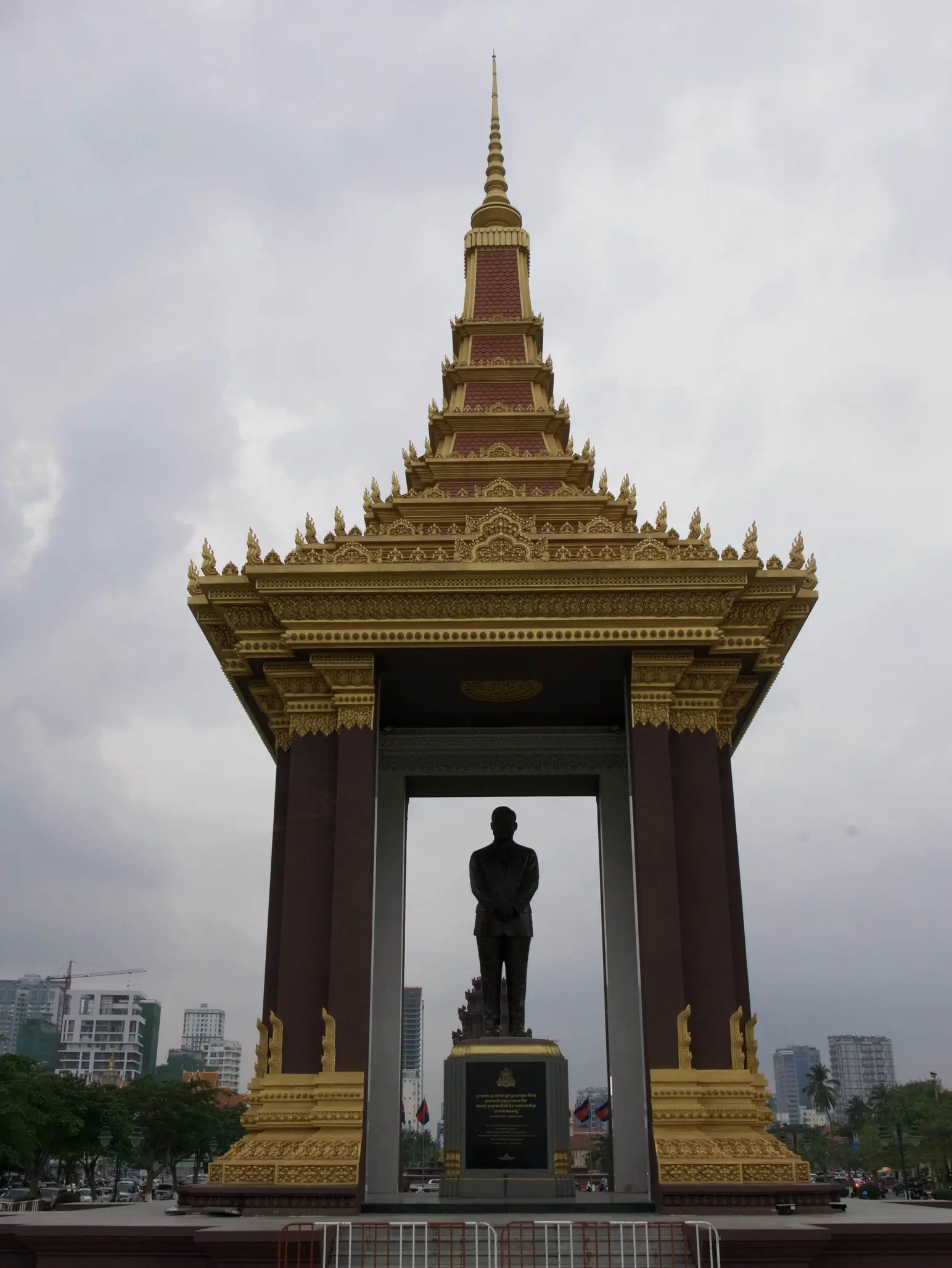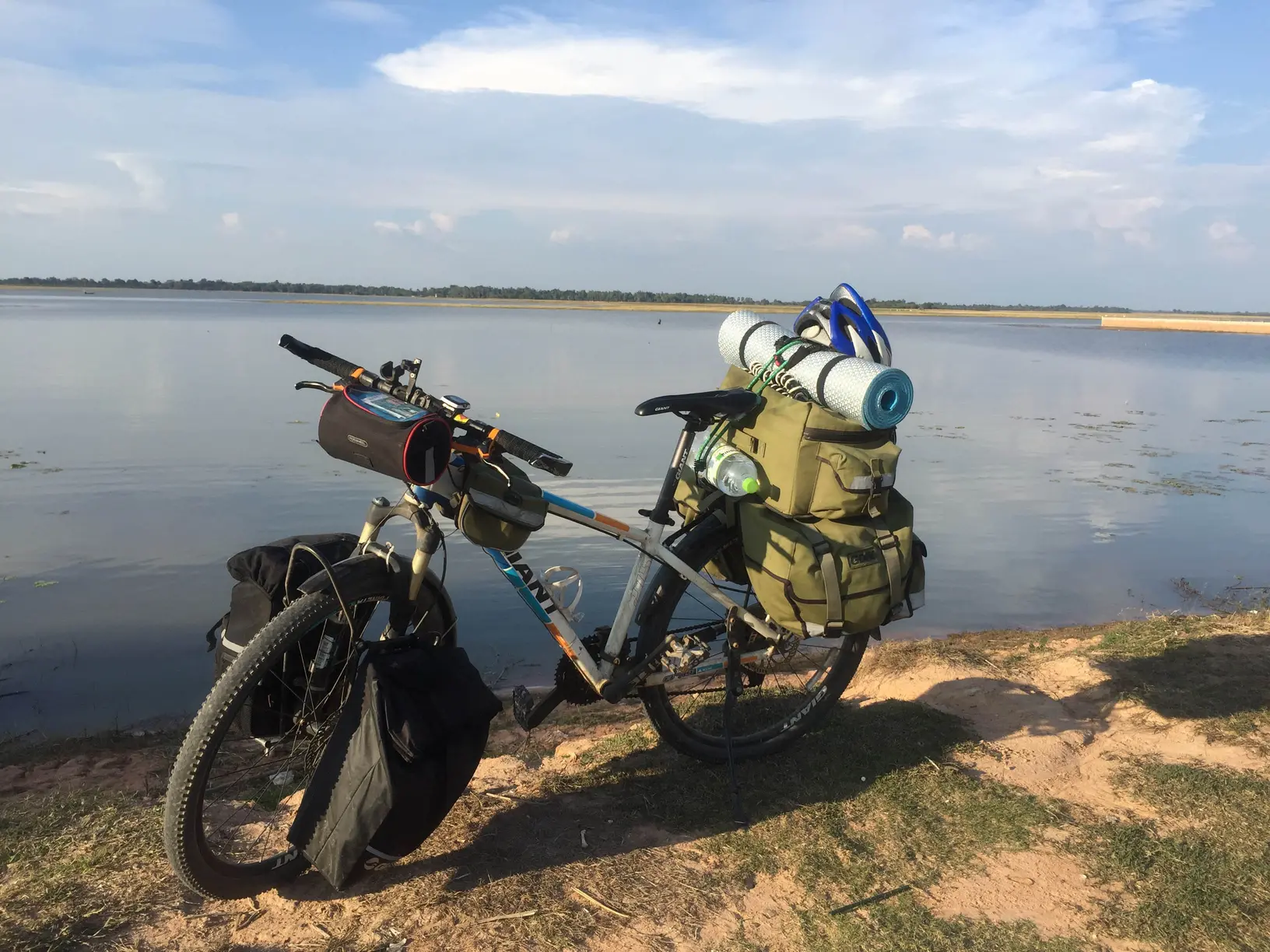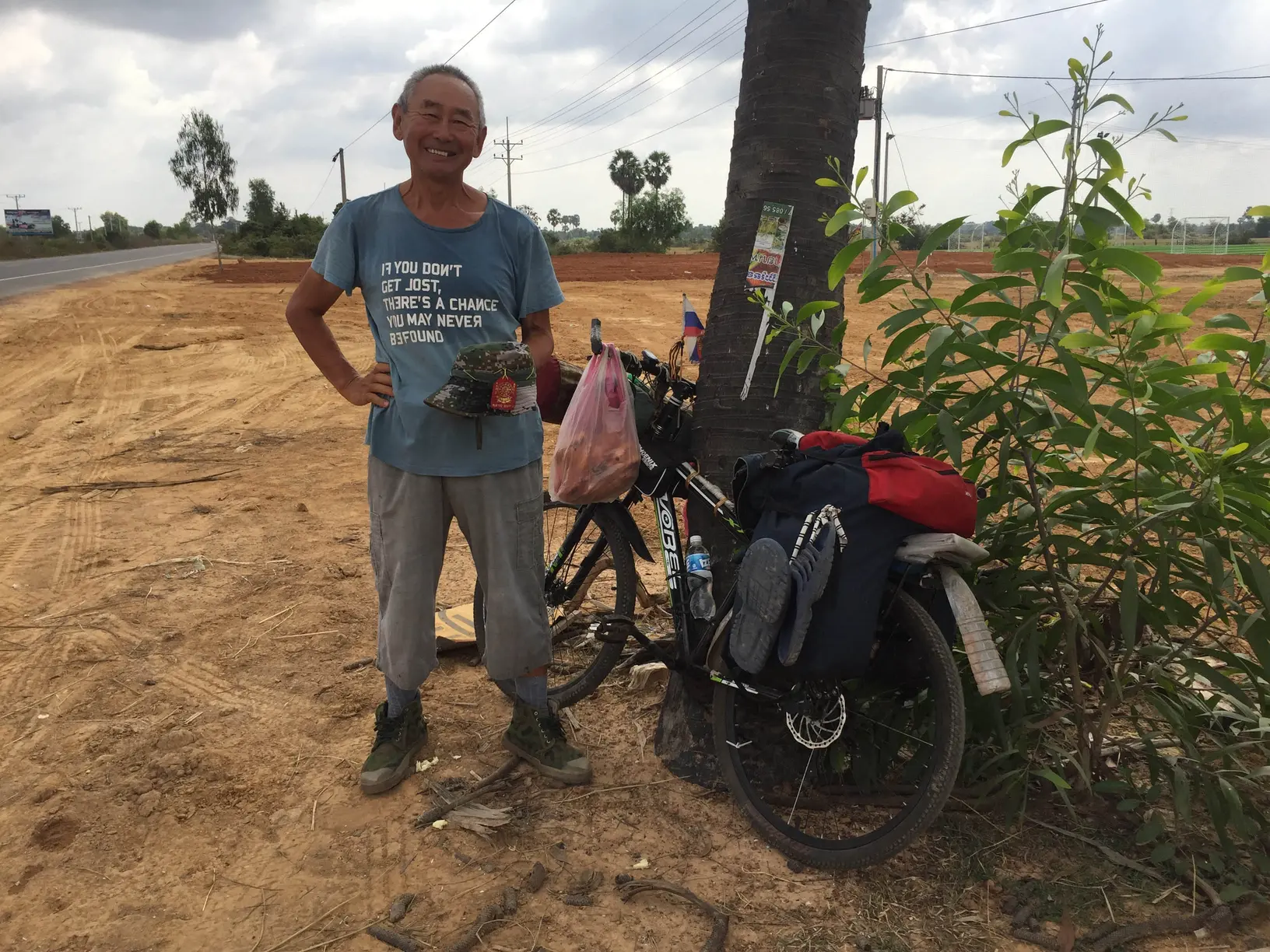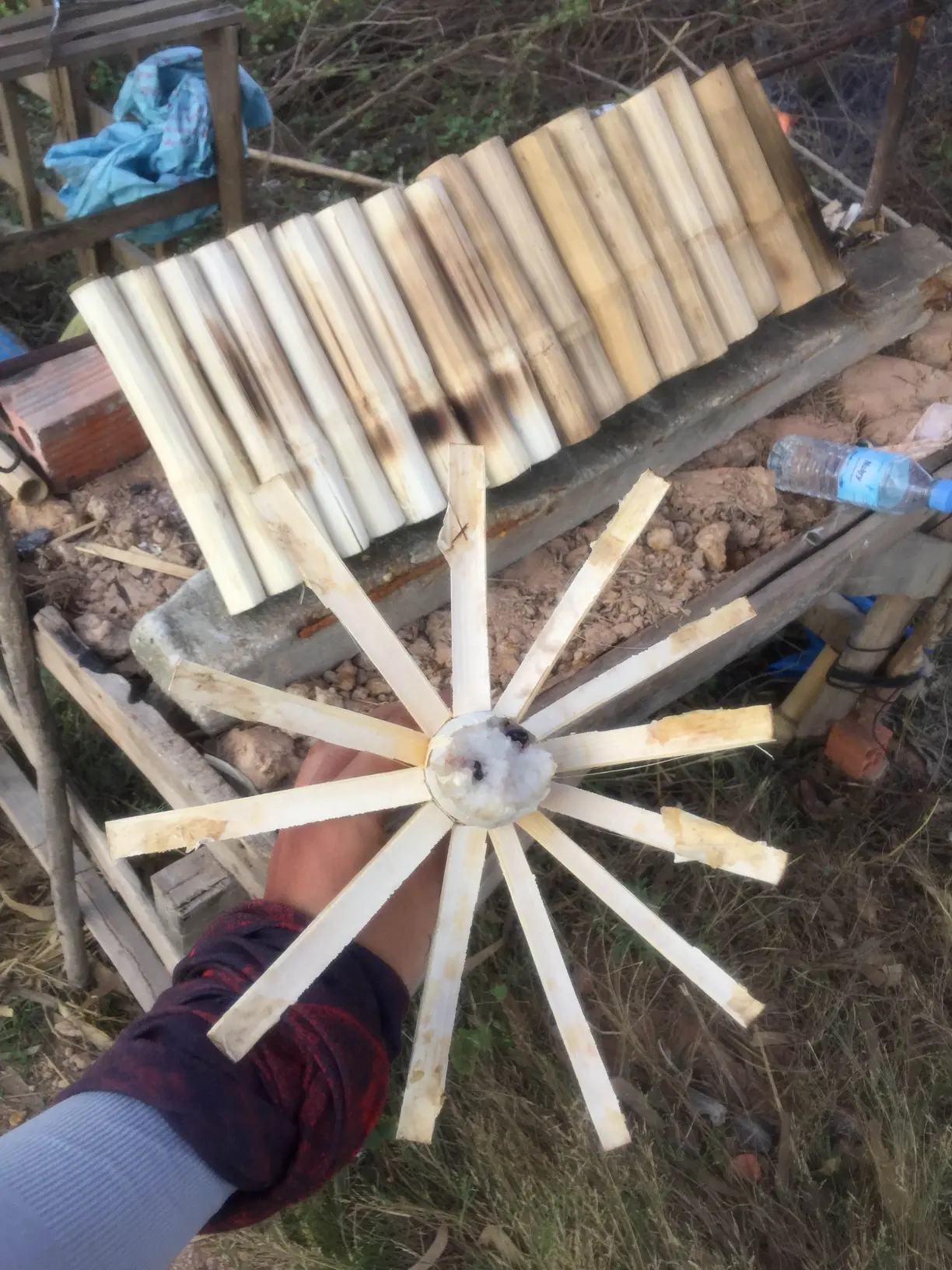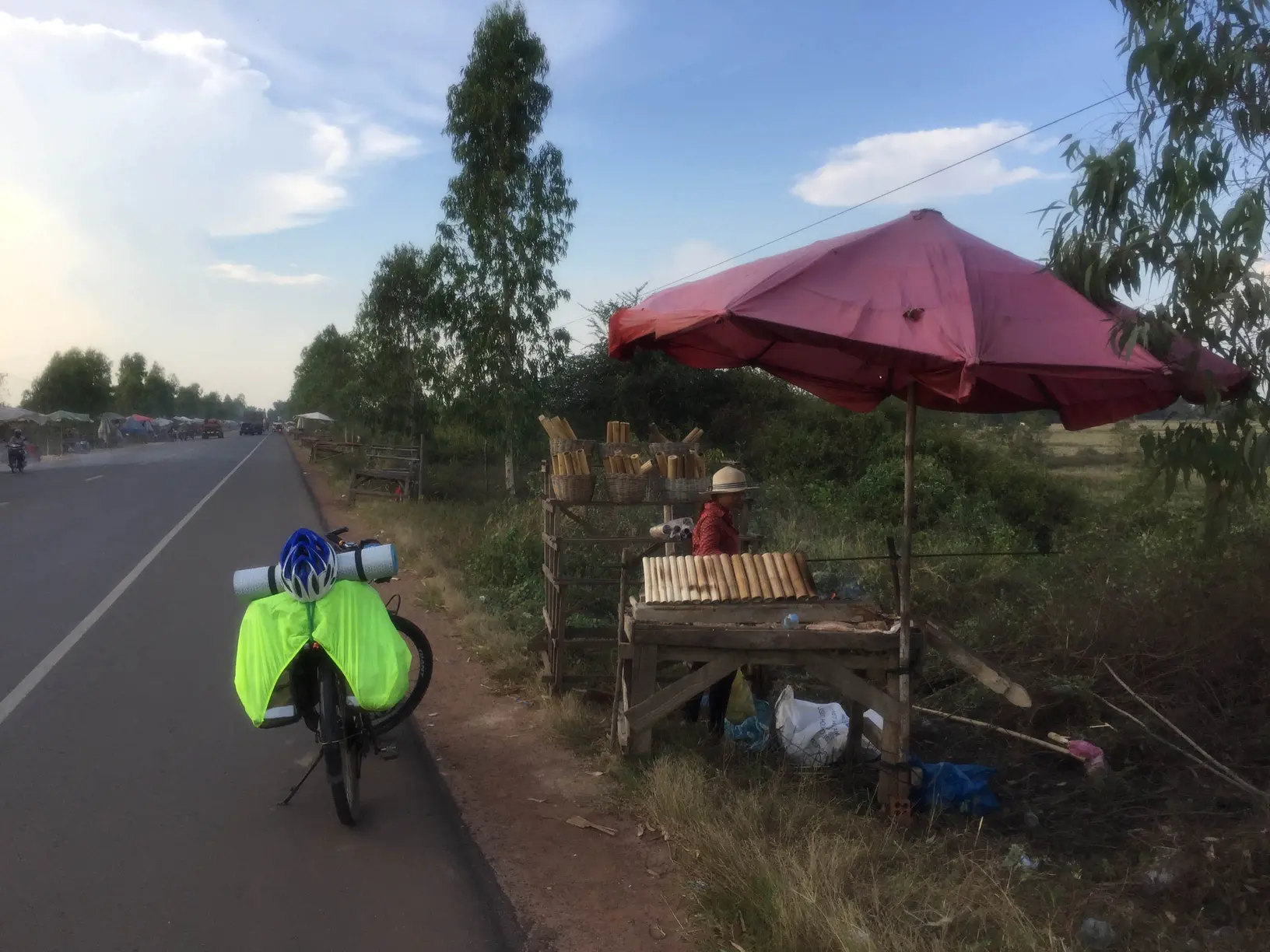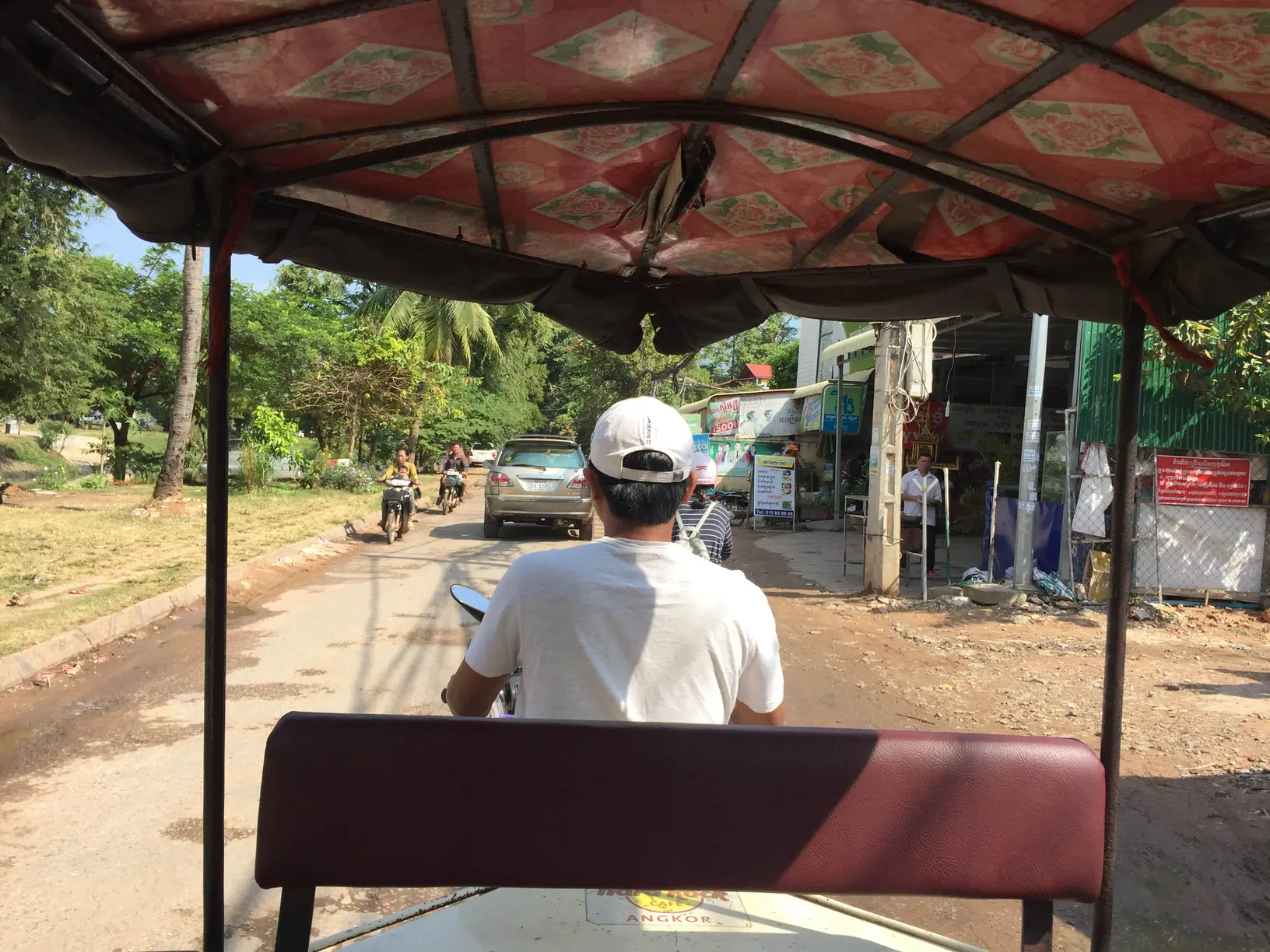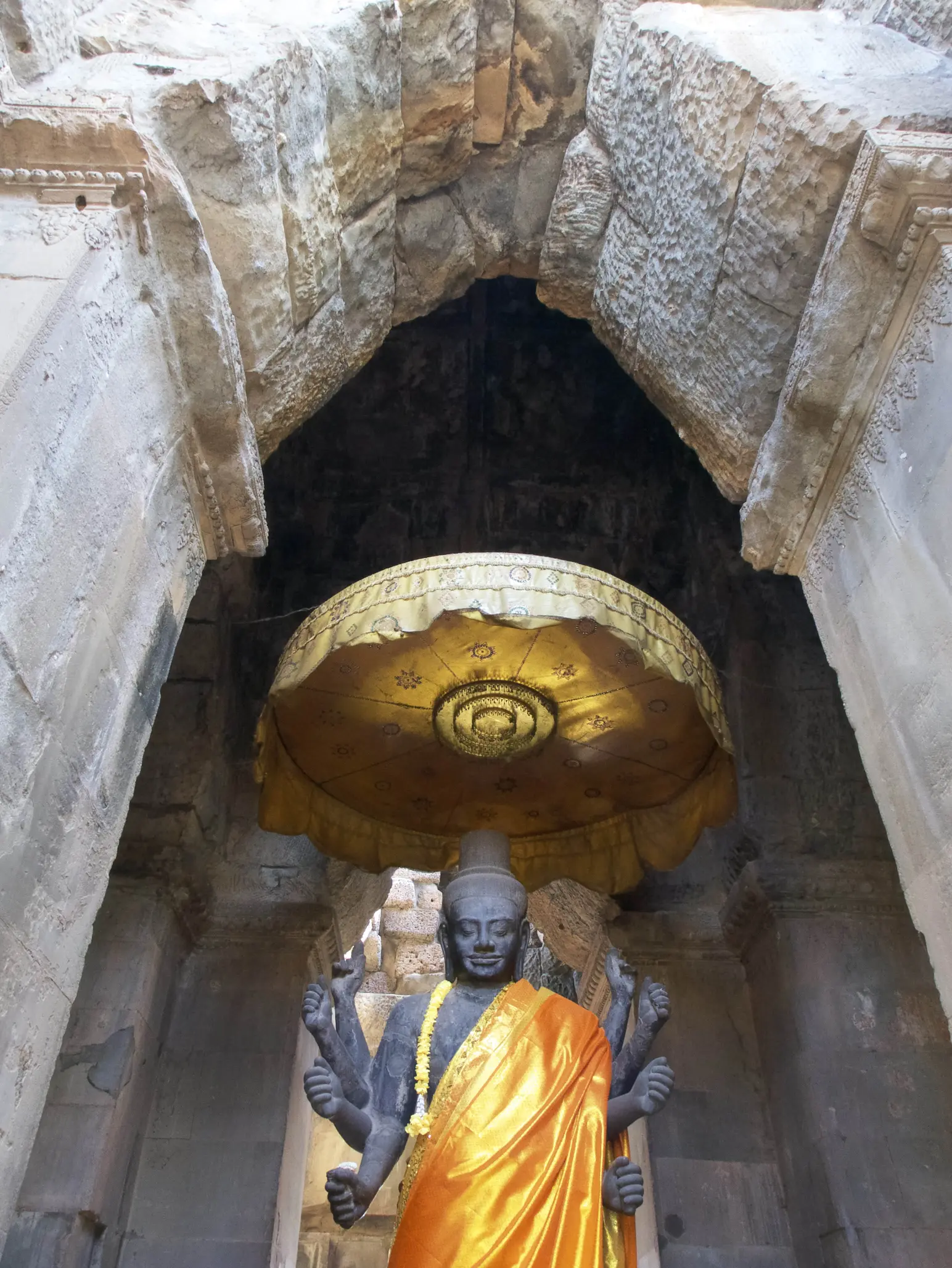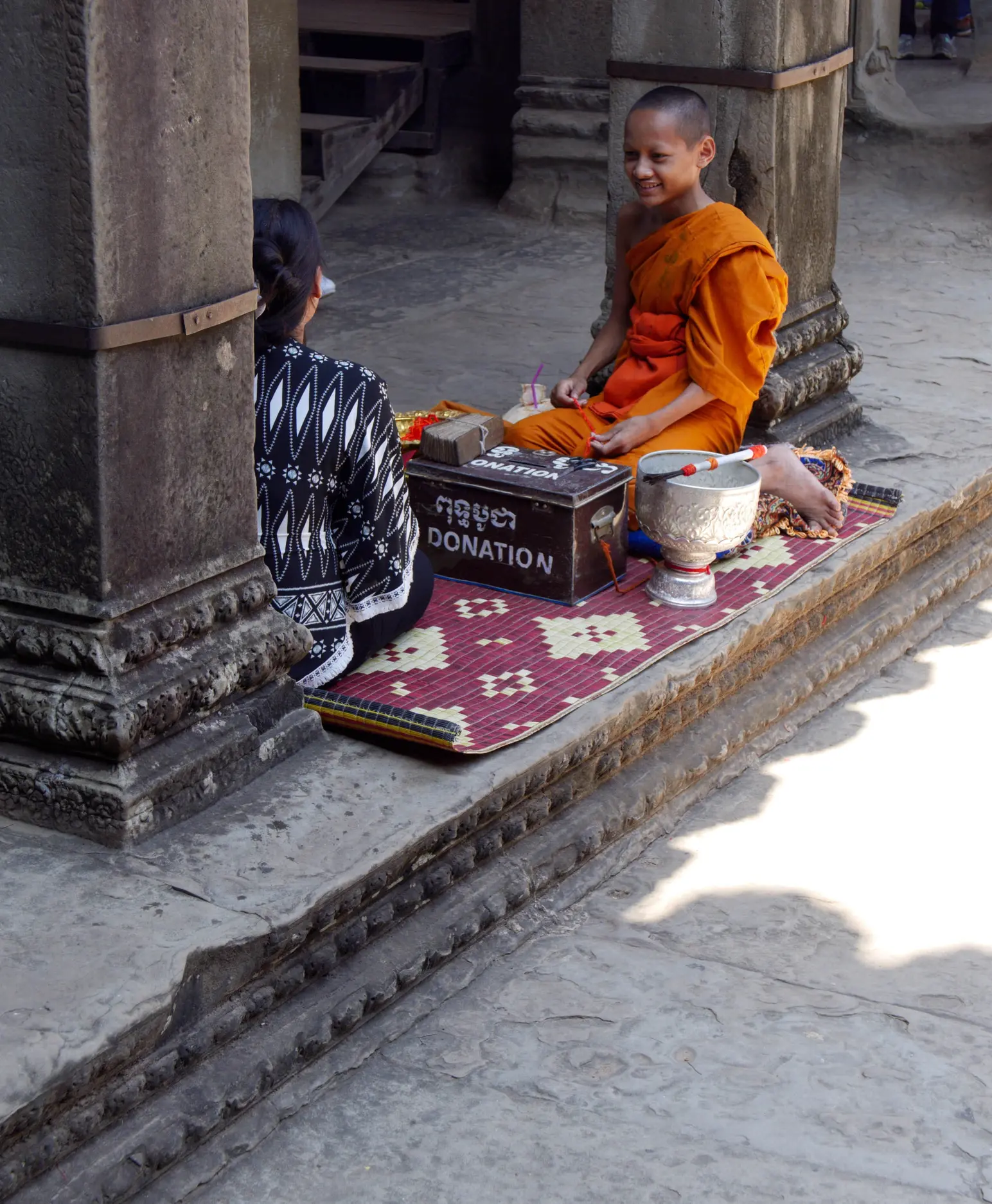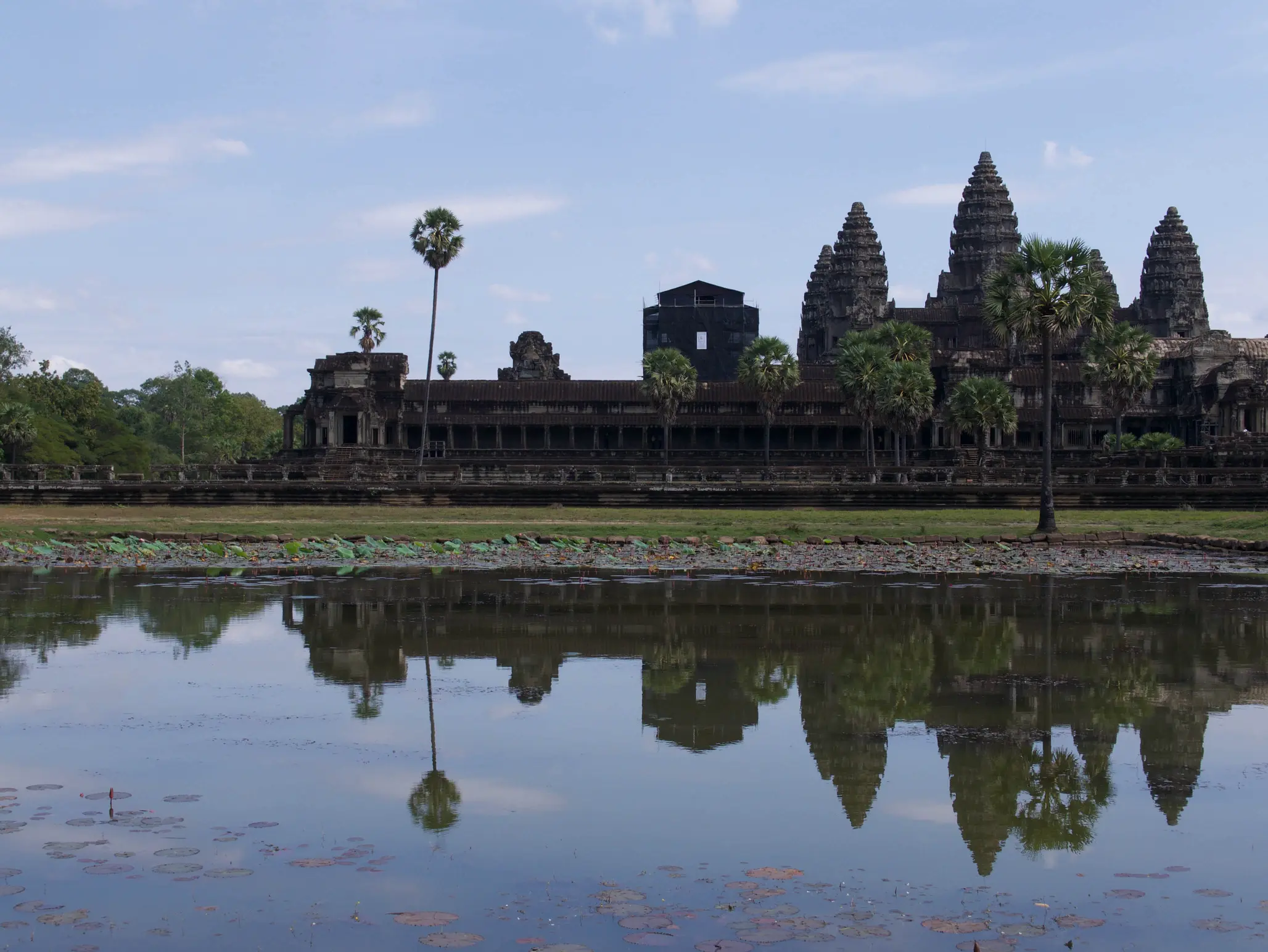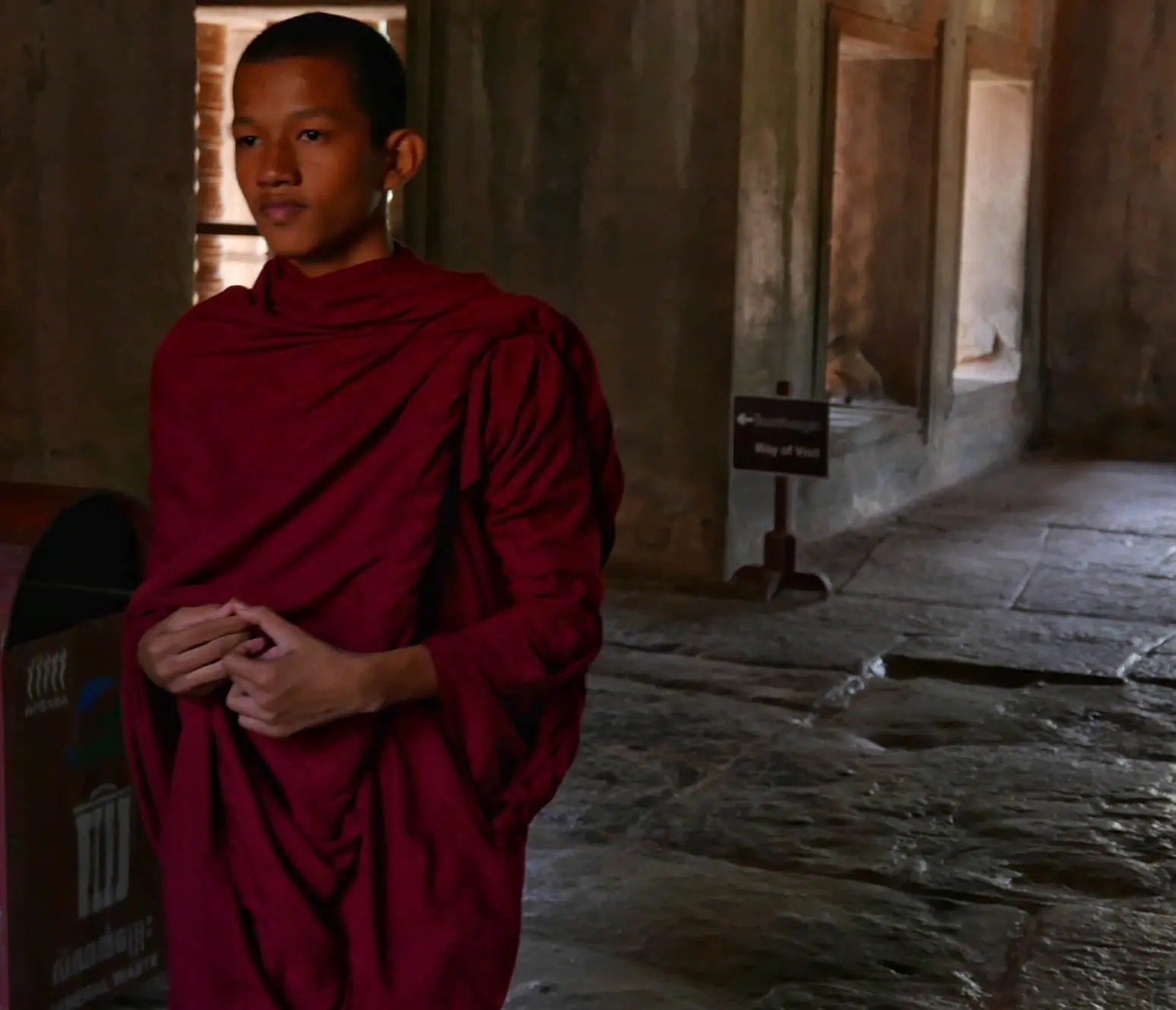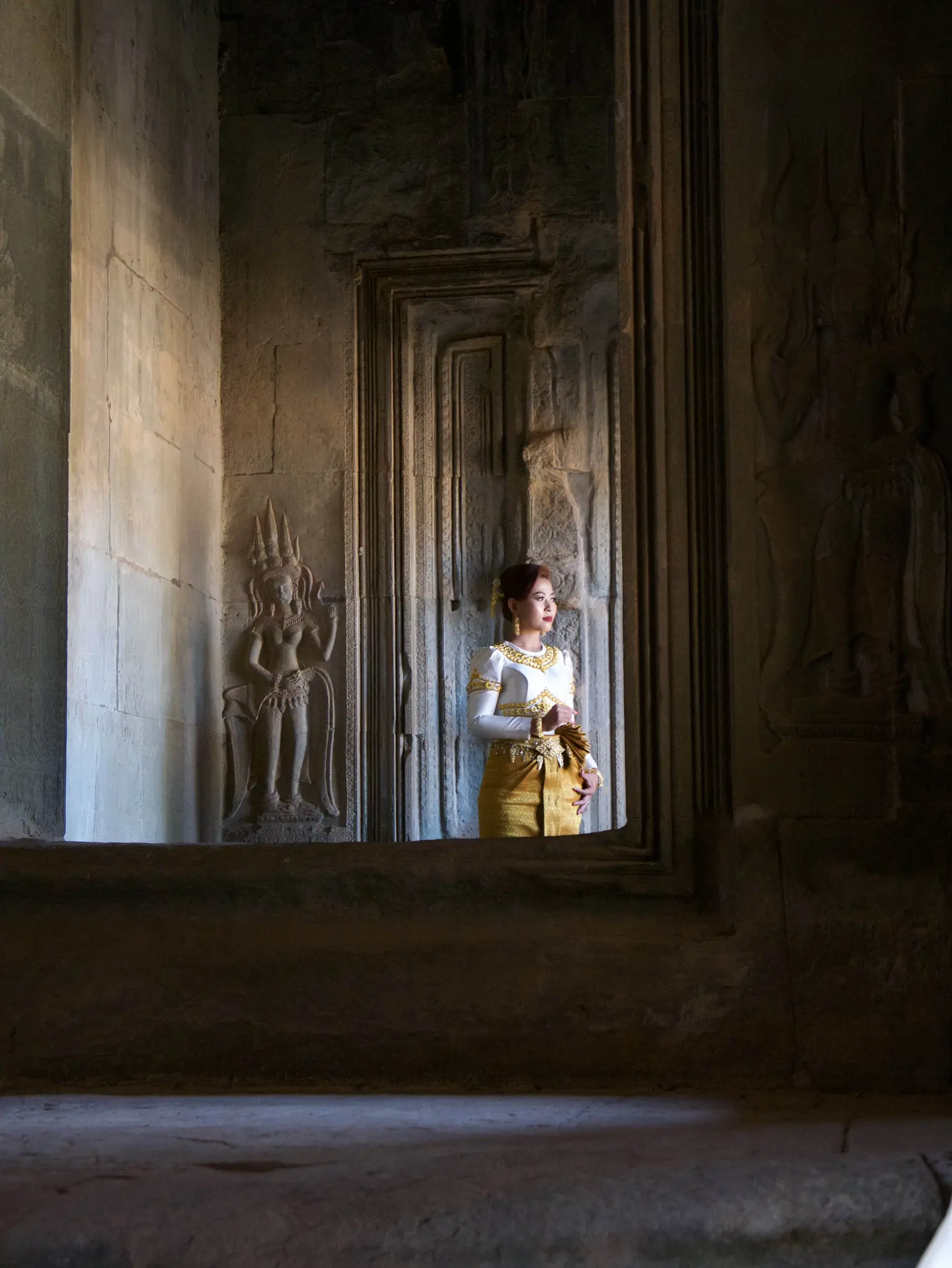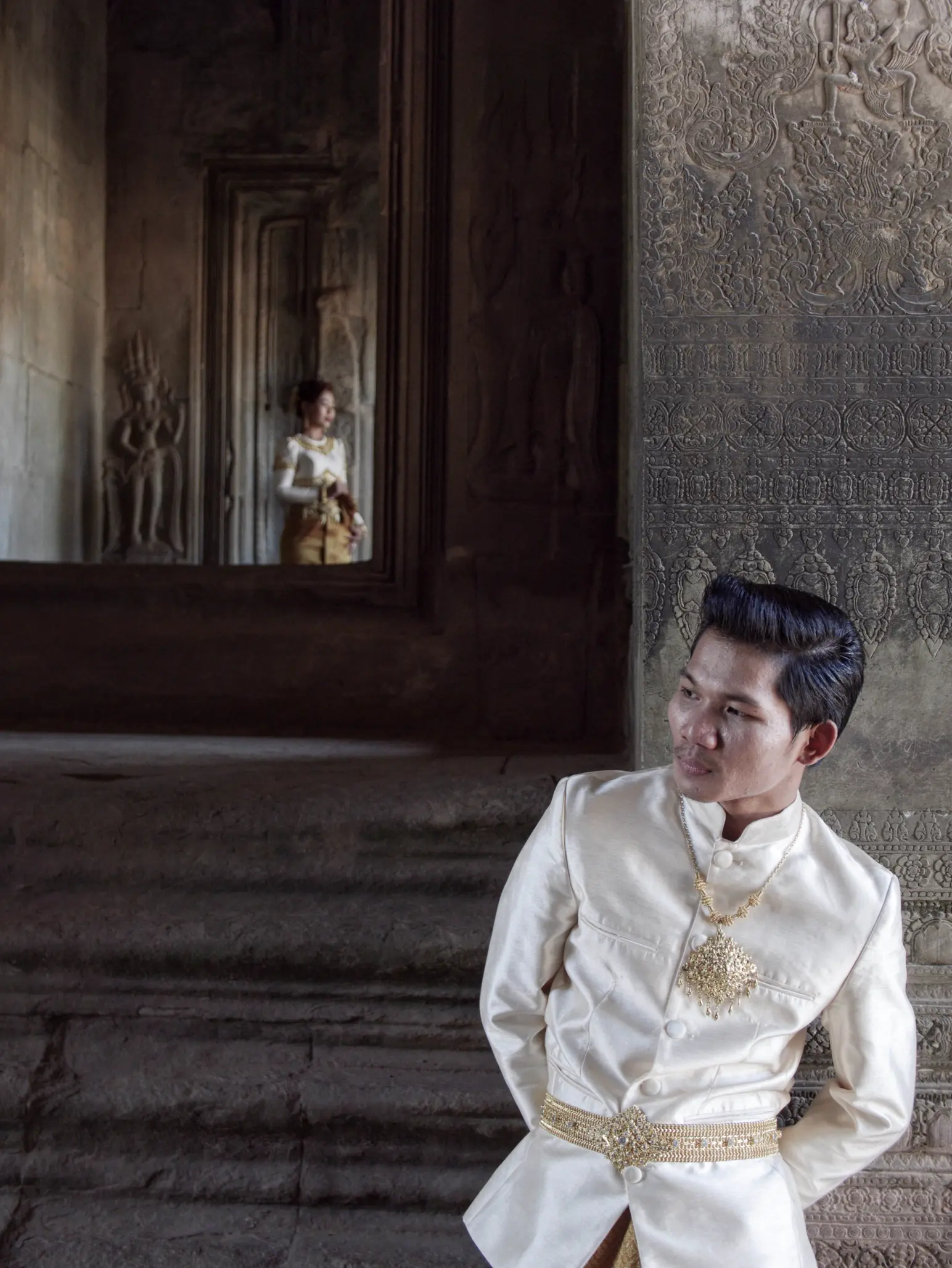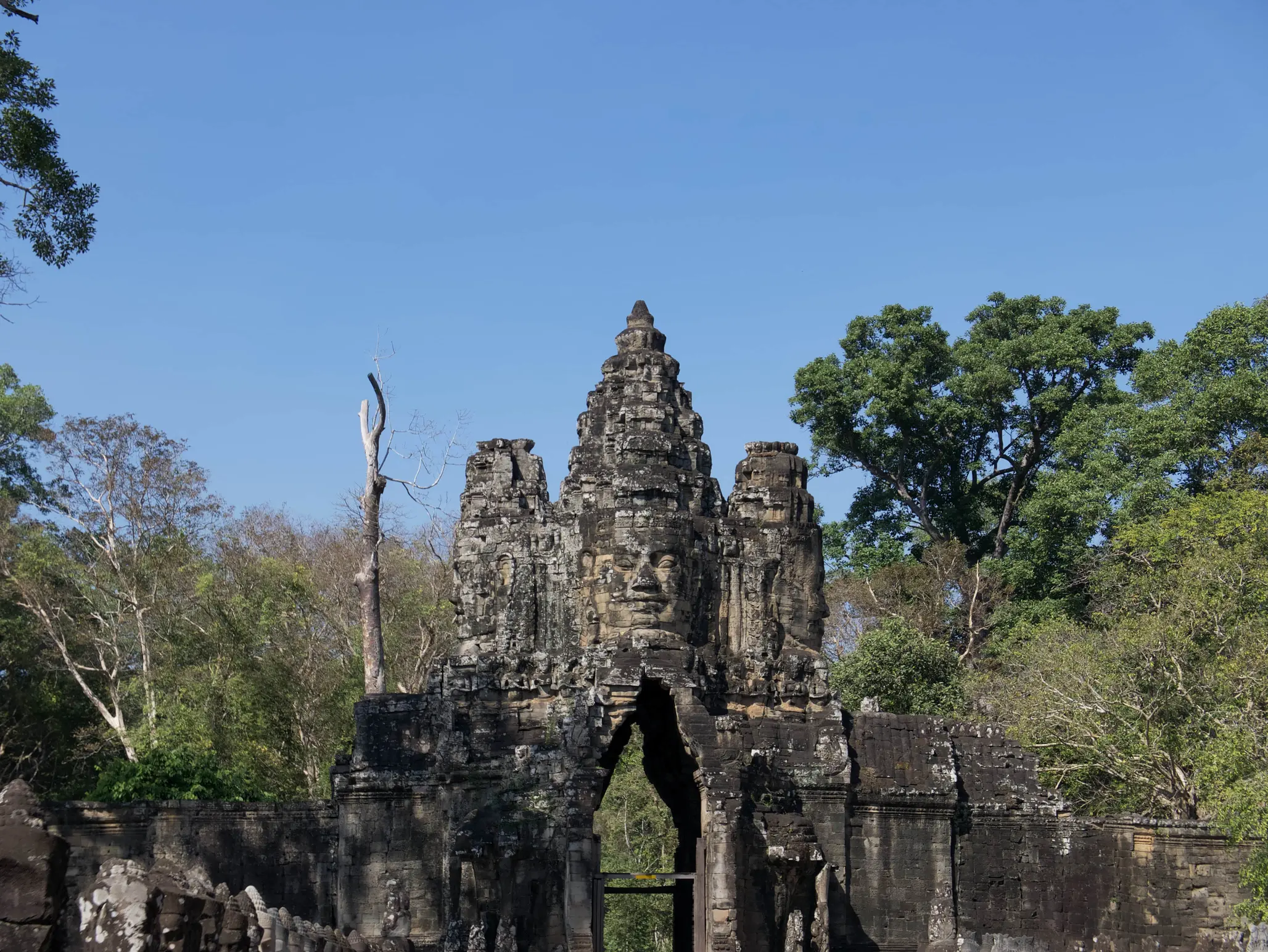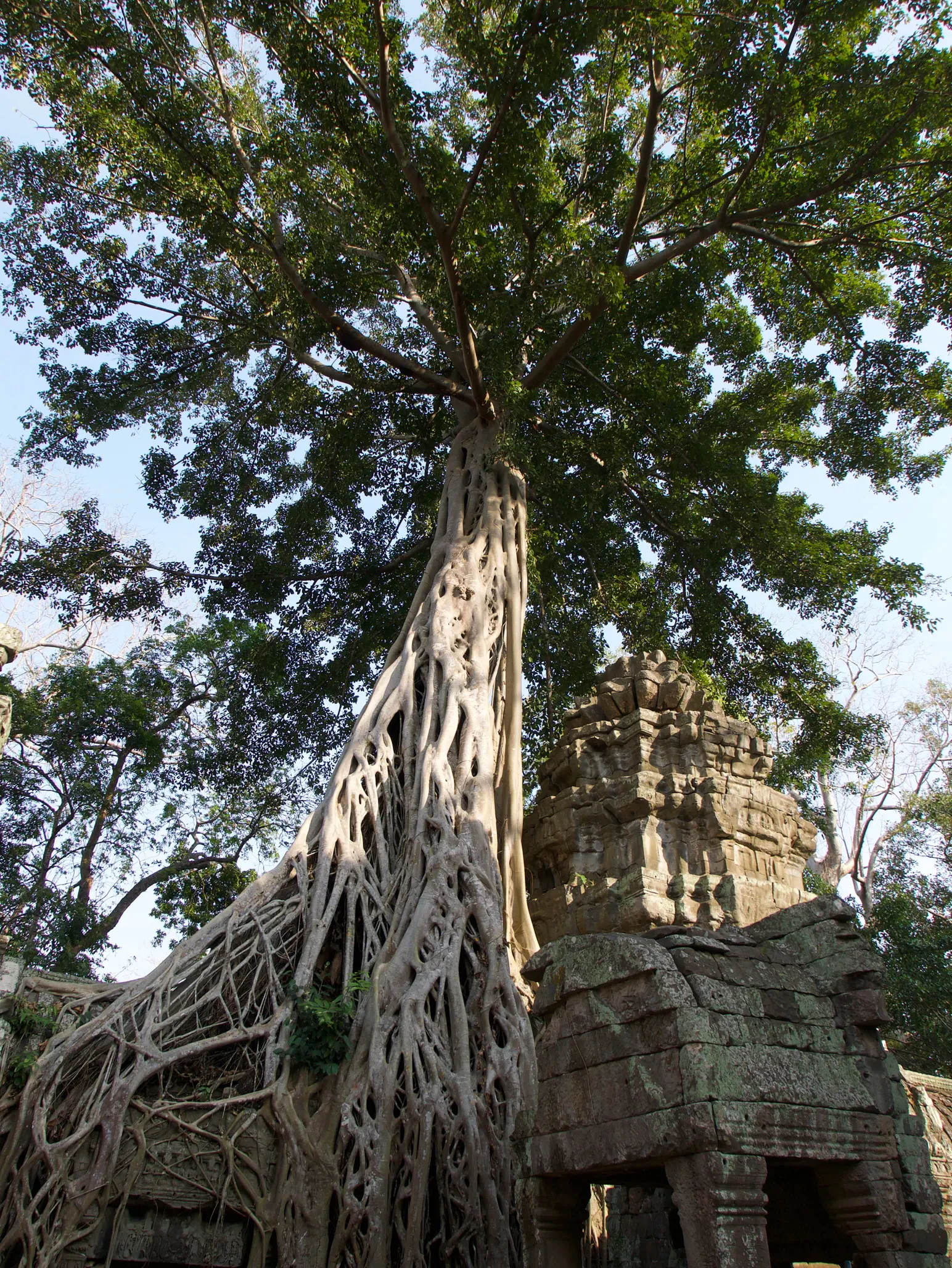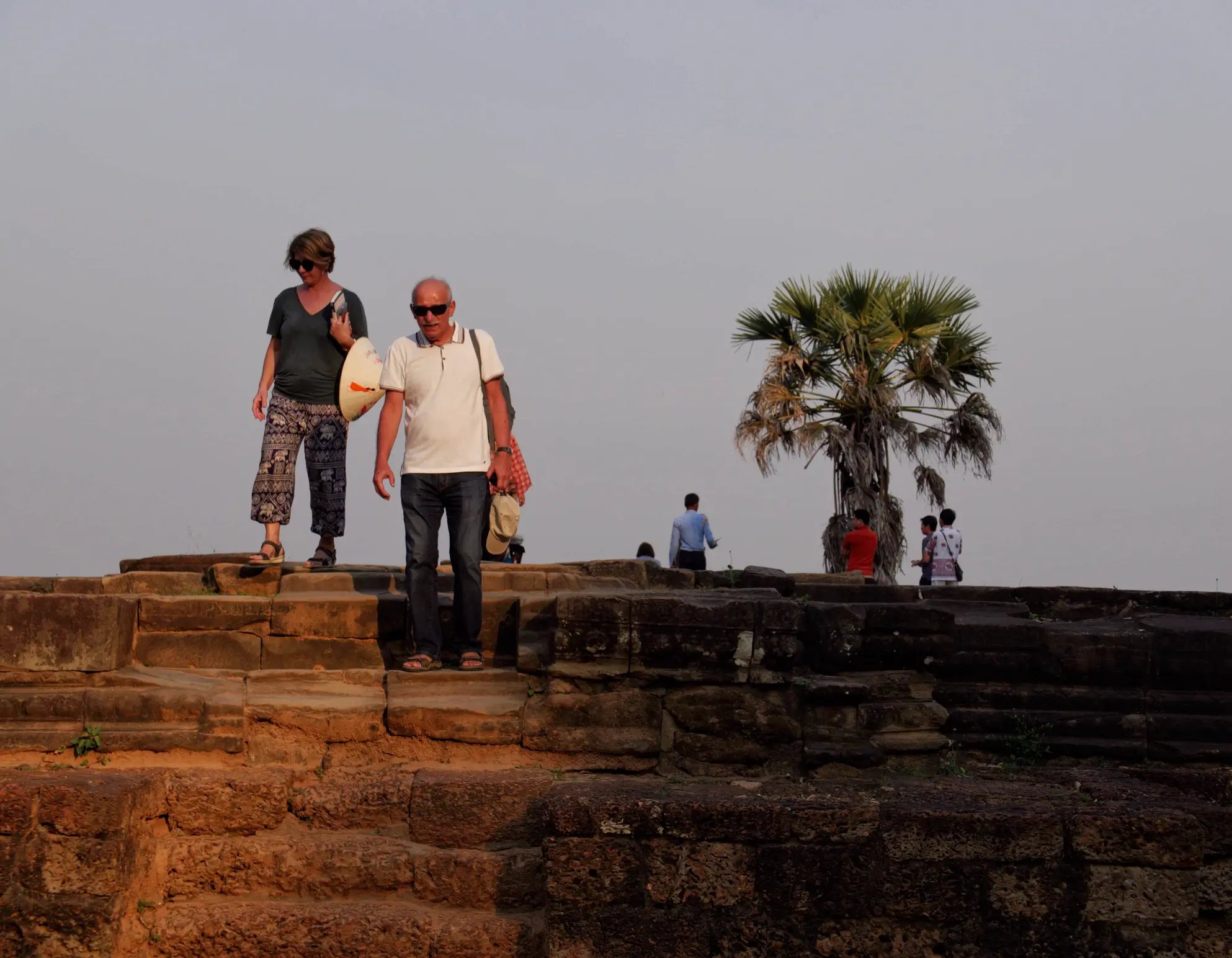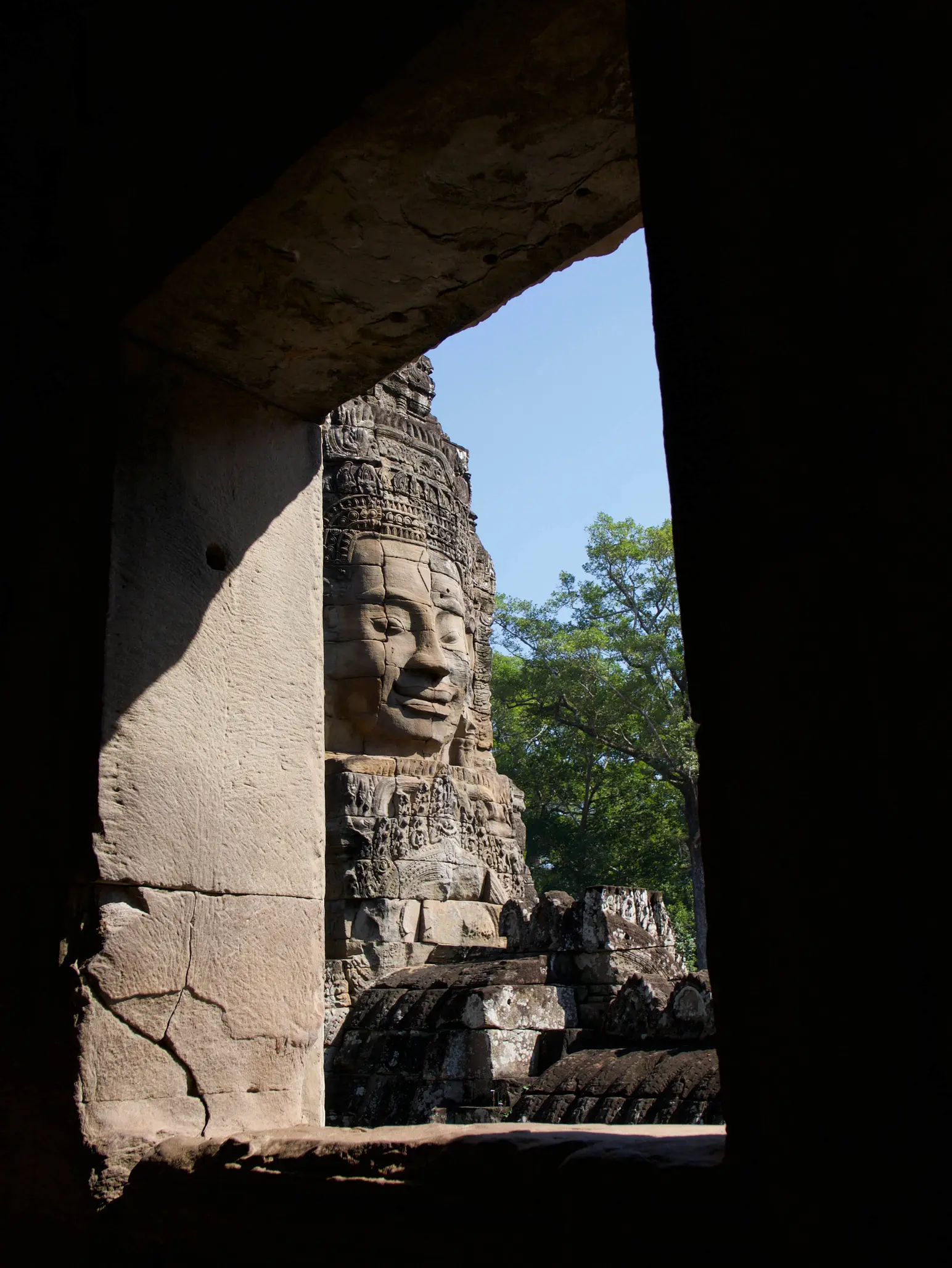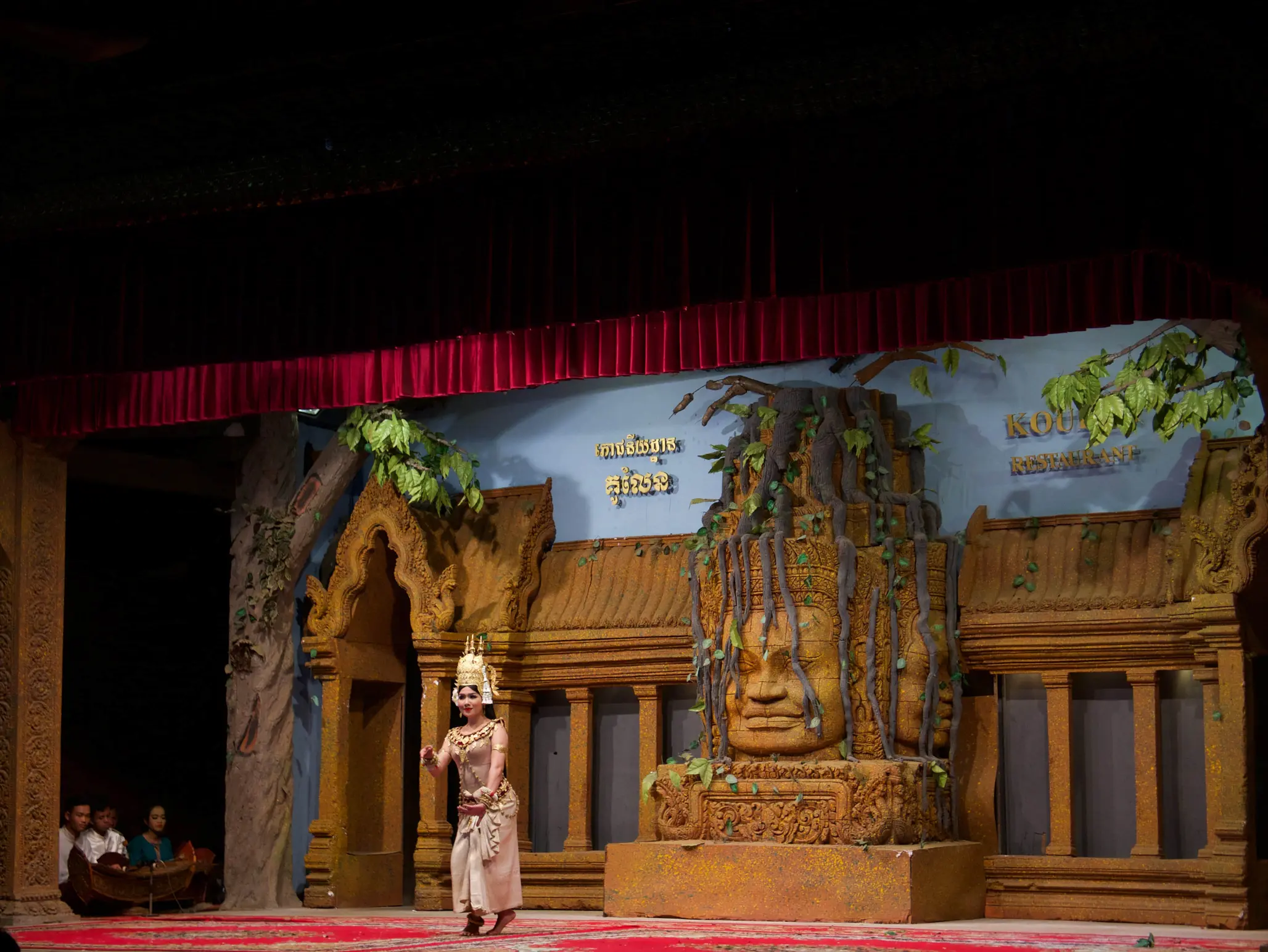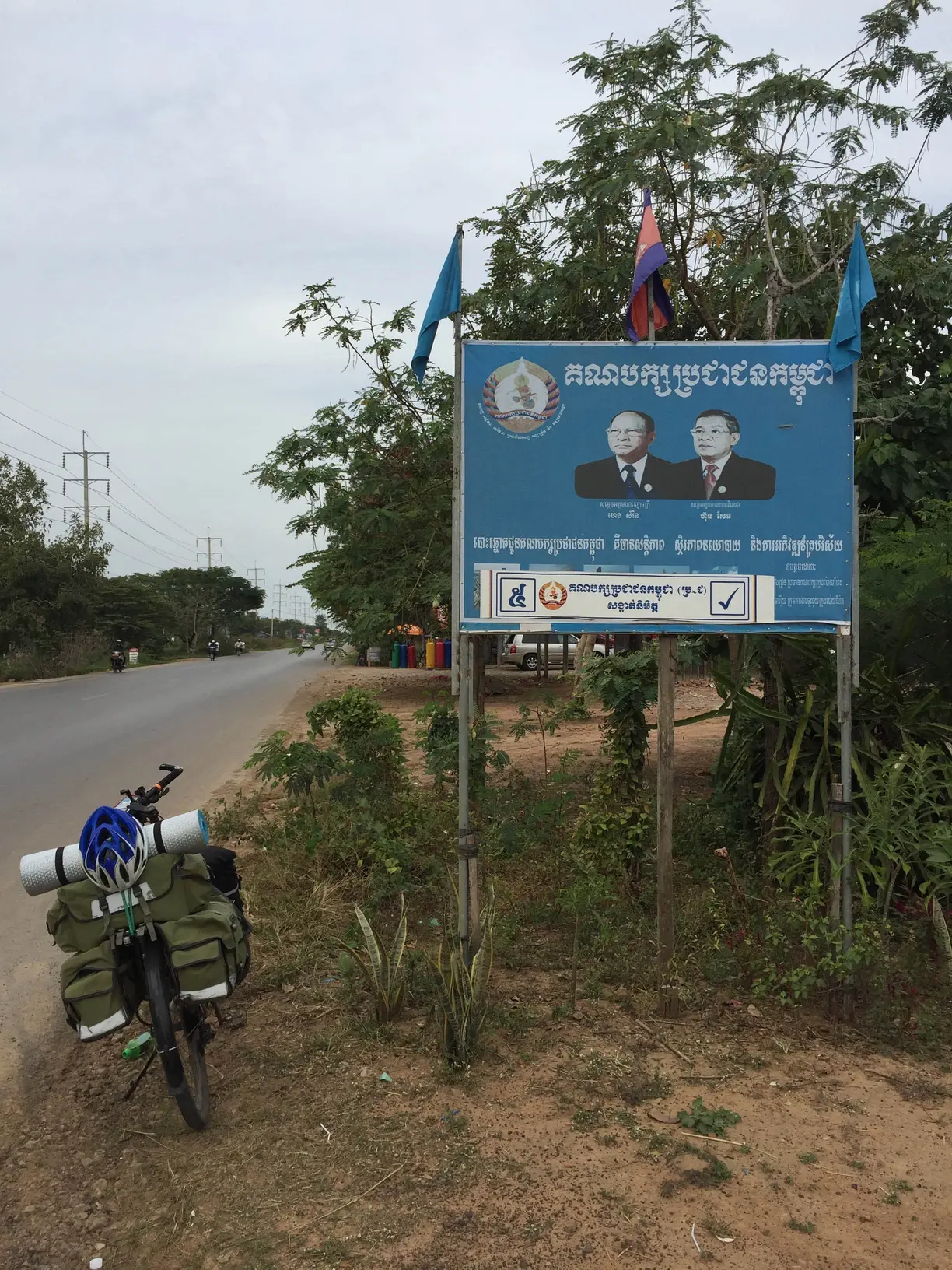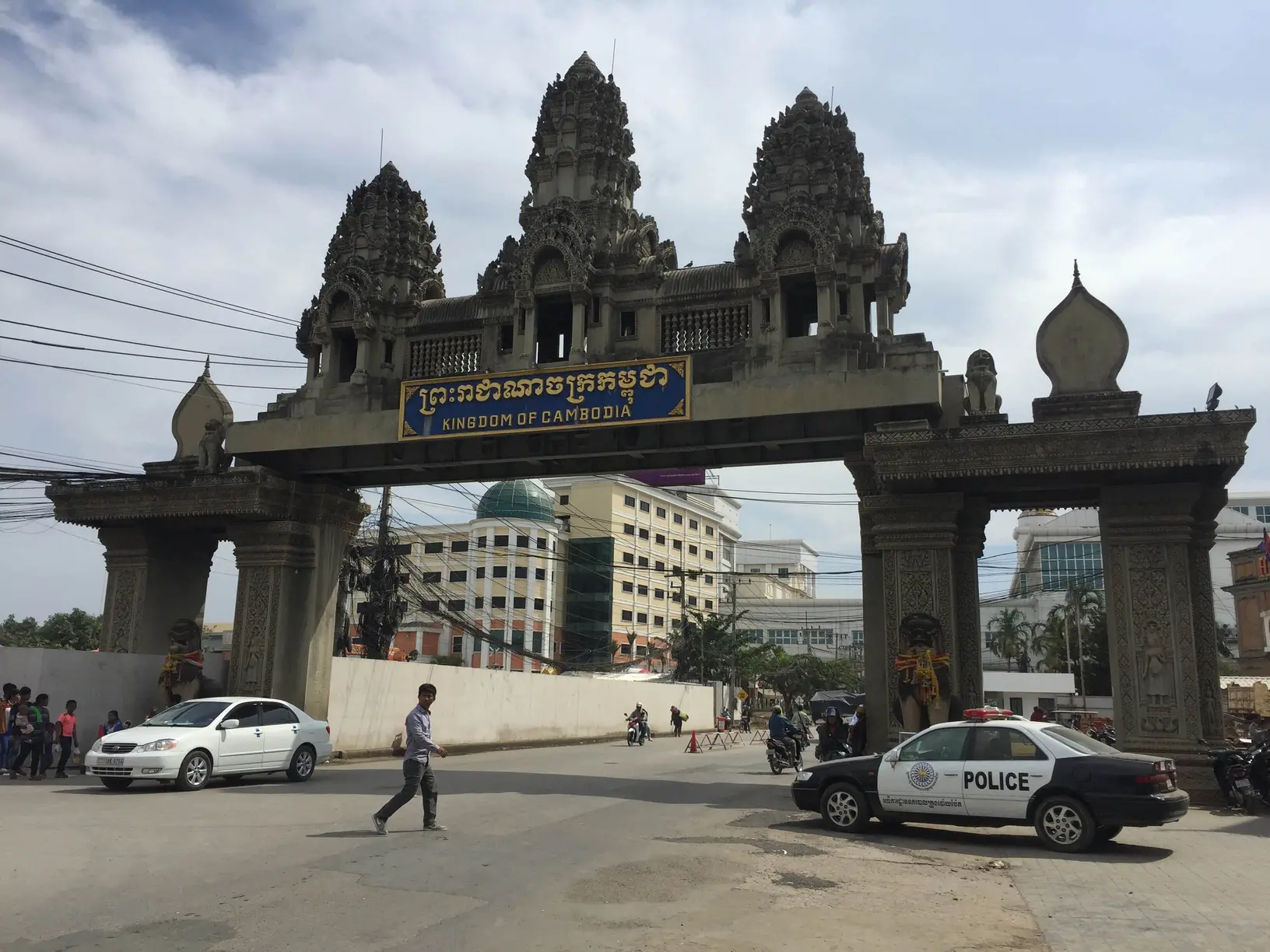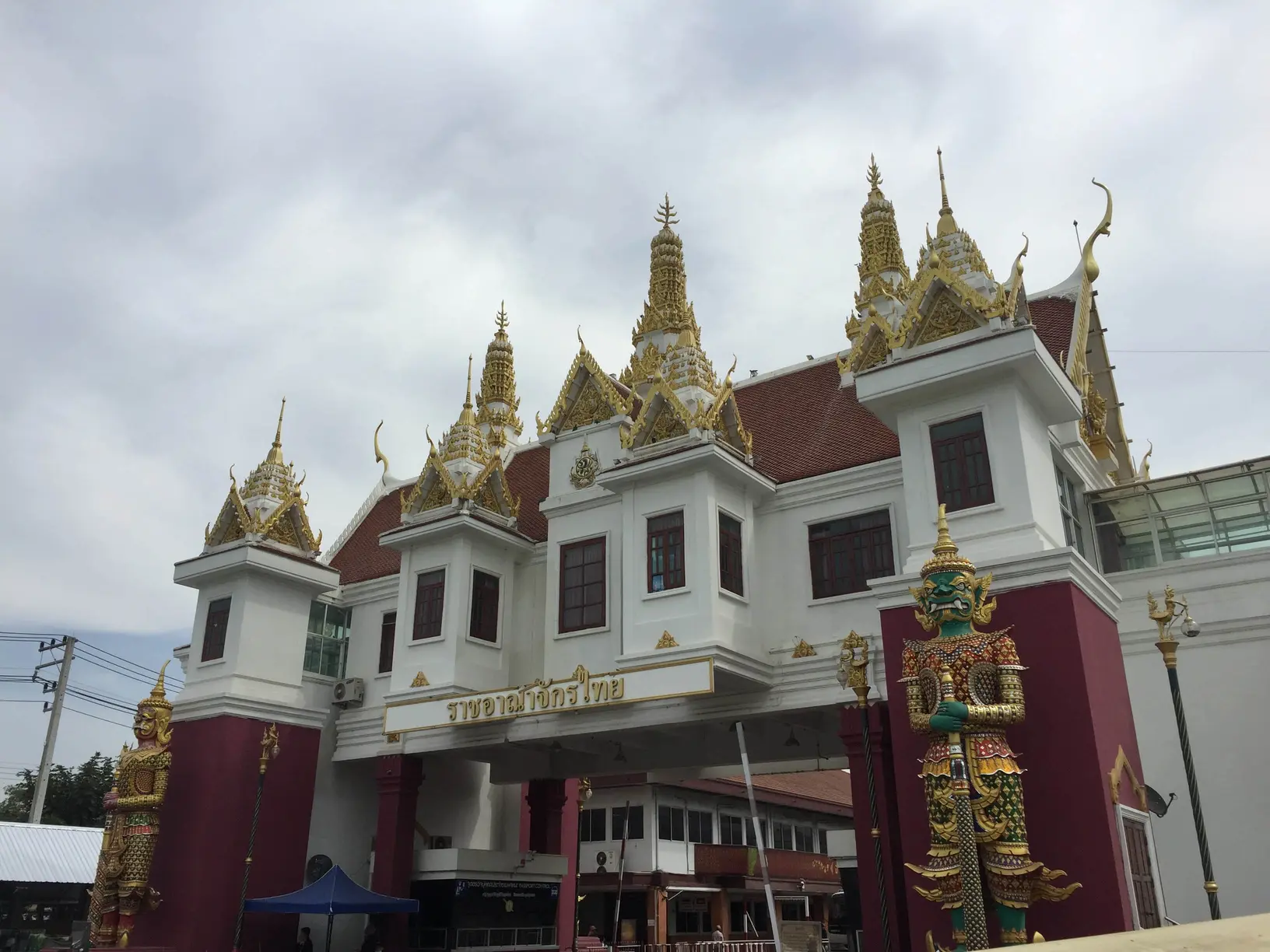1
Bavet-Moc Bai is the earliest land border crossing between Cambodia and Vietnam. It usually takes only six or seven hours to travel by car between Phnom Penh and Ho Chi Minh City. The main vehicle on the road is not the bus, which has a higher fare and is often chosen by foreigners. The locals prefer a kind of box truck, which carries goods when idle and passengers when busy. There are no seats in the cargo compartment, and people stand and squeeze together, fitting in twenty or thirty people.
Cambodia is not a mountainous country, and the roads are mostly flat but often bumpy and uneven. The cars on the road are very fast. Bicycles are very common everywhere, but there are not many people who travel by bike, especially in areas outside of a few big cities. When this kind of truck passes by, the passengers behind often look at me in unison.
Riding on the road, in addition to the occasional attention, I can also see various temples. Unlike the Mahayana Buddhism practiced in Vietnam, Theravada Buddhism is the mainstream in Cambodia.
The architectural style of Theravada Buddhism is quite different from that of Chinese Buddhism. The temples all have pointed towers, mostly in yellow, with triangular facets on the top, and the Buddha statues are also unique.
Besides, there are no advertisements around the road, and the signs along the road are either road signs or leaders’ campaign signs. Two men wearing glasses and suits look solemnly into the distance, below are rows of Khmer characters, a white background, and a square bracket with a tick inside. From the first day I entered Cambodia until I left, they were always with me.
Occasionally, I can also see some local houses, mostly in the style of stilt houses. A few pillars stand on the ground, about two meters above the ground, and the houses are built with bamboo and wood on the pillars. People live on the top, and farm tools, motorcycles, and livestock are stored and parked underneath.
The roadside stalls are often more shabby, with a shed made of bamboo and wood, and some groceries inside. One or two big red or green boxes are placed on the outside, which are for selling drinks. Refrigerators are not common in the stalls, and Cambodia is hot all year round, so the shopkeepers often buy large ice blocks and pile them at the bottom of the box, and then put the drinks on top, selling them to customers.
After passing a stall, I stopped and bought two drinks, 3000 riels. In Cambodia, the US dollar and the legal currency riel are common, and some areas near Thailand also accept baht. The general exchange rate is one US dollar equals four thousand riels, and the habit of giving change varies from merchant to merchant. Some will give US dollars, some will give riels, and some will be a mix of large US dollars and small riels. I gradually realized that the faster I adapted to this complex conversion, the easier the travel would be.
I heard that people preferred to use US dollars in previous years, because the exchange rate was strong and not easy to depreciate. After the economy improved in the past two years, the acceptance of riel also gradually increased. But in hotels everywhere, quoting in US dollars is still the first choice.
It was five o’clock after drinking the drinks, and I thought I had to find a place to stay first. I opened Booking and saw that the most densely populated area of hotels was of course the capital Phnom Penh more than a hundred kilometers away. I pulled the map to my vicinity, and the hotel flags were sparse. The number of hotels also reflects the economic level and population situation of the region, and there is no doubt that there is no big city around.
I chose a hotel about twenty kilometers away and hurried over by bike. An hour later, before the sky completely darkened, I arrived in Chbar Ampov. The whole city was not very bright, and there were not many street lights on the street. The vendors who were doing business set up simple electric lights for illumination, and a large group of flying insects often gathered under the yellow light.
After a lot of effort, I finally arrived at the hotel, paid the money, got the key, and the boss returned my passport after looking at it, and I didn’t have to detain it anymore. The place where I stayed was good, by a small river, a bungalow, similar to a motel. After tidying up, I went out to look for food.
There were not many people on the street, and it was dark everywhere, and there were not many shops that were open. I couldn’t find rice, so I ate two bowls of rice noodles at a roadside stall.
I got up early the next day and hurried on the road. The sun was scorching, and I was not in a good state. I stopped to rest and buy drinks when I saw a stall, and I couldn’t ride anymore.
At this time, encountering some interesting things can boost people’s spirits. I saw it in a village not far from the Mekong River, a steel frame that stretched for more than ten meters erected a shed, covered with colorful cloth and flowers, and a loudspeaker stood on a high pole next to it.
I was riding and riding, and it suddenly appeared in my sight. I took a closer look and found that it occupied half of the road. At first, I didn’t know what it was for. When I got closer, I looked inside and found that it was full of guests, and a pair of newlyweds on the stage were smiling and toasting. The passing vehicles and pedestrians all had the same tacit understanding, and they would not be affected by this small section of road.
On the way behind, I often saw wedding banquets on the road. In rural China, people often dry crops on the road, making the best use of everything. In Cambodia, people hold weddings on the road, killing two birds with one stone.
After the sun set, I rode for more than an hour relying on the light of the flashlight, and arrived at the capital of Cambodia-Phnom Penh.
2
Phnom Penh is located in the central plain of Cambodia, at the confluence of the Mekong, Tonle Sap and Bassac rivers. It has been the capital of Cambodia since the 15th century.
Similar to the cities in Vietnam, the main transportation tool for Cambodian residents is motorcycles rather than cars. When I arrived at the suburbs of Phnom Penh, there were no street lights on the road, which made me wonder if I had reached my destination. After following a large army of motorcycles across a bridge, the hustle and bustle of the city appeared before my eyes.
The location of the hostel where I stayed was good, near the Royal Palace of Phnom Penh, and it only took a few minutes to walk there. After tidying up, I went out for dinner and returned to the hostel to rest. I planned to stay in Phnom Penh for two days, go around and visit various places, and wait for Jiapan to arrive.
The next day, I slept until I woke up naturally, and after having breakfast, I went to Wat Phnom first. Wat Phnom is the origin of Phnom Penh and one of the symbols of Phnom Penh. Phnom Penh (Phnom Penh) was formerly known as “Bainangben”, Phnom means “mountain”, and Penh means “Ben” surname, so Phnom Penh means “the mountain of Lady Ben”. According to legend, an old lady named “Ben” found a Buddha statue in the Mekong River and brought it back to her home for worship. Later, the incense became more and more prosperous, and this place gradually grew into a city. The earliest Chinese who came here communicated in dialect, and “Bainangben” sounded like “Phnom Penh”, and the name Phnom Penh has been used ever since.
You can walk to the top of the mountain along the steps, and the railings on both sides are carved into the shape of snakes. It is called a mountain, but it is actually a low mound. On the top of the mountain, you can overlook the whole view of Phnom Penh, the golden spires of the royal palace, the wide and surging Mekong River, and the colorful houses. This season has the most tourists, and the pleasant northeast wind blows gently, and it doesn’t feel too hot to walk on the road.
After leaving Wat Phnom, I went straight to the Royal Palace. The architecture of the Royal Palace has a traditional Khmer style and a strong religious color. The towering spires and the yellow or white halls are all eye-catching. I queued up, bought a ticket, and followed a large group of people into it. I raised my camera when I saw something new, and went in and out of various halls and buildings, and finally came to the Jade Buddha Temple. The Jade Buddha Temple is named after a jade Buddha from Myanmar, and it is covered with thousands of silver bricks, so it is also called the Silver Palace. It was originally a place for the king and the royal family to worship and fast. Now it has become a royal museum, with many fine products.
After a few hours of shopping, the Royal Palace was about to close, and I hurriedly took some photos as the crowd receded. At the exit, a band was playing Cambodian music, and I recorded a short video with my phone.
Outside the Royal Palace is a wide square, where locals play, cool off, and walk. I saw a lot of people kicking rattan balls. Rattan balls are balls made of bamboo and are very popular in Cambodia.
Walking forward from the square, I turned a direction and saw the Independence Monument. The Independence Monument was built to celebrate the independence from French colonial rule. There are dragons carved on the monument. On some specific holidays, people will come here to offer wreaths.
I met Jiapan again at night, and we had a meal together. I left first the next day.
The distance between Phnom Penh and Siem Reap is more than 200 kilometers, and it can be reached in two days. After leaving Phnom Penh, I rode more than 130 kilometers, and then there were more than 90 kilometers left. On the road, I met a Russian grandfather who traveled around the world by bicycle. He was in his sixties or seventies and was in good health. I exchanged each other’s cycling plans and could only shout amazing.
There are often stalls on the side of the road, selling not fruits, but rice, a kind of rice roasted in bamboo tubes with charcoal. When I first saw it on the side of the road, I was a little surprised and didn’t know what it was selling. When I saw them more and more frequently, I decided to stop and take a look.
The stall owner was a young woman, wearing a round hat, and her skin was slightly dark. The stall was made of discarded wooden boards, rectangular, with charcoal underneath and more than a dozen bamboo tubes on top. A big umbrella was set up next to it to shade the sun. Behind it was a trapezoidal wooden shelf with six bamboo baskets on it, and the bamboo baskets were filled with bamboo tubes to be roasted. There was only one kind of product on the whole stall, bamboo tube rice, and nothing else.
The price of bamboo tube rice was not high, 2000 riels, equivalent to more than three yuan in RMB. After buying it, the stall owner would use a knife to split the bamboo tube, break and tear off the tube body piece by piece. Because the rice was already stuck to the film in the tube, even without the protection of the tube wall, the rice could still maintain its original posture.
I took the bamboo tube rice from the stall owner’s hand and took a big bite. It tasted a bit like glutinous rice, sticky. There were also some dates or beans wrapped in it, adding a lot of flavor.
After eating, I continued on the road and just met the school leaving. A bunch of students poured out, and many of them rode bicycles. They saw me, and a few of them had the idea of competing with me. They suddenly accelerated behind me and ran to the front, looking back and laughing at each other.
The closer to Siem Reap, the more prosperous the sides of the road. There were more stalls, more motorcycles, and more cars.
When I arrived in Siem Reap, I just encountered the peak of traffic. There were motorcycles, cars and trucks everywhere. With the flexible posture of the bicycle, I was able to weave through them with ease. Relying on the guidance of the map, I passed through one alley after another, and finally arrived in front of the booked hotel.
But what was in front of me? A iron gate was closed, and there was no one inside. I checked again, and this was the address given by Booking. I saw a crowd of people next to me, and they were leveling the ground. I asked them for help, and a big brother kindly responded to me.
He carefully checked the address and pictures on Booking, and confirmed that it was this place, but he told me that this was not a hotel at all, but a private residence. Then he called a few friends and asked them if they knew any information about this hotel, but nothing came out. Finally he asked me, did I pay a deposit in advance, and I told him no, I chose to pay at the store. After that, the big brother suggested that I find a new hotel as soon as possible, and it was about to get dark.
I nodded, thanked the big brother, got on my bike and left the alley.
I later reported this problem on Booking, but didn’t get any effective response.
3
When traveling, you never know what kind of city awaits you ahead. You can only imagine what its palaces, temples, streets, markets and food will look like based on your past experience.
The name of Angkor Wat is well-known to me. I have heard a lot of images, pictures and customs from childhood, but most of them are just superficial. Siem Reap is a city built on Angkor. Its hair, skin, blood and bones are all related to it. There is a statue with not very exquisite craftsmanship in front of the hotel, and there are pictures of Angkor City everywhere in the restaurant. The foreign faces walking on the street are greeted by tuk-tuk drivers from time to time: Angkor Angkor.
There are basically two more mature routes for visiting Angkor, commonly known as the small circle and the big circle. The small circle is the essence of Angkor Wat, and the most famous attractions such as Bakheng Mountain, Angkor Thom and Bayon Temple are among them. The big circle is an extension of the small circle, and people who have more time will choose it.
Hiring a tuk-tuk to Angkor is the best choice for most tourists. Tuk-tuks are similar to tricycles, and the drivers are usually enthusiastic and familiar with the entire Angkor site. If you are not familiar with the site, they will also give suggestions and make a better tour route.
A day’s journey usually starts in Siem Reap. After breakfast, you can get on the tuk-tuk and set off. The driver will drop off the tourists at the designated place, and then the tourists will go to visit. The drivers will wait outside and come back to pick up the tourists at the agreed time and go to the next place.
The tuk-tuk first took me to the ticket office, where I bought a three-day ticket. After the system was improved, tourists can visit for three consecutive or non-consecutive days within a week.
Most tourists first arrive at Angkor Wat, also known as Angkor Temple. It is the national symbol of Cambodia and the birthplace of Khmer culture. I jumped off the tuk-tuk and followed the crowd of tourists to the entrance. After checking the ticket, I stepped on a temporary pontoon bridge and entered Angkor Temple.
Angkor Temple is surrounded by a large moat, and the majestic building is located in the middle. After entering the gate, the first feeling was that the scenery on the TV and images appeared in front of me in reality, but it felt a little unreal.
How to describe this feeling? The past imagination and reality overlap, as if magnifying a certain sensory experience, the broken statues, the mottled city walls, the flying Buddha heads, this kind of heavy memory torrent rushed into the depths of my mind. Whenever I think of it in the future, I will never forget it.
After leaving Angkor Temple, I went to Bayon Temple, which is unique among the many exquisite buildings. The builder was one of the greatest monarchs of Cambodia, Jayavarman VII. During the most prosperous period of the Angkor dynasty, he ordered craftsmen to carve his face on the statues. These huge portraits looked down on the world from all corners, symbolizing power, rule and divine power.
During Jayavarman VII’s reign, the Angkor dynasty converted from Hinduism to Buddhism, and Buddhism became the most important belief of the Khmer people.
Later, I visited many temples one after another, and then I couldn’t remember much. I only remembered a huge reclining Buddha, many steep and tall stone steps, broken walls, and bright silk hanging on the Buddha statues.
The last place was Ta Prohm Temple, which was different from other temples. After hundreds of years of washing, it has been swallowed by the forest. Tall trees rooted on the city walls, murals and pagodas, reaching the sky, dense branches and leaves blocked the sun, only casting a little shade.
In the next two days, Jiapan also arrived in Siem Reap. On the first day, we hired a tuk-tuk to go to Angkor, and on the next day we planned to ride our own bicycles to play. There are not many tourists who visit on foot, because the temples are far apart, and riding a bicycle is just right. There are also many bicycle rental points in Siem Reap.
After visiting a few temples, we decided to watch the sunset at the Royal Bath. Generally speaking, there are a few classic locations to watch the sunset in Angkor, the pond side of Angkor Temple, Bakheng Mountain and the Royal Bath. Compared with the previous two, it is very quiet here, not many tourists, and locals like to fish near the bath.
It is called a bath, but it is actually very large, very large, and it is more than enough to row a boat in it. There used to be a temple in the center of the pool, but it collapsed later, and now only the stone base is left.
Back to Siem Reap at night, we found a buffet restaurant, where there was a fairy dance performance. Fairies are one of the most famous images of Angkor temples, and many exquisite murals are decorated with them.
After Siem Reap, Jiapan and I planned to ride to Bangkok together, and then he went to Myanmar and I went to Malaysia.
The original text of this article is in Chinese, translated by Copilot(GPT-4).

